World War II by country
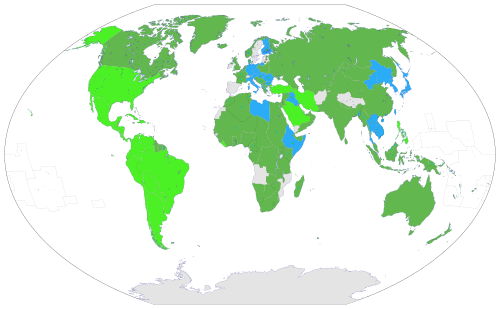
| World War II |
|---|
| Navigation |
|
|
Almost every country in the world participated in
The countries involved in or affected by World War II are listed alphabetically, with a description of their role in the conflict:
Participants/Non-Participants During WW2
Neutral Powers
Axis Powers
Allied Powers
Afghanistan
Under Prime Minister
In 1941, Western press reported that Amanullah Khan, a former king who lost his throne in a civil war in the 1920s, was working as an agent for Nazi Germany in Berlin.[6] It is believed he was involved in plans to regain his throne with Axis help.[7] Following the Axis loss in Stalingrad in 1943, the plans cooled off and were never executed.[8]
Albania

After the
In October 1941, small Albanian Communist groups established an
Germany occupied Albania in September 1943, dropping paratroopers into Tirana before the Albanian guerrillas could take the capital, and soon drove the guerrillas into the hills and to the south. Berlin subsequently announced it would recognize the independence of a neutral Albania and organized an Albanian government, police, and military. Many Balli Kombëtar units and leaders collaborated. The partisans entirely liberated Albania from German occupation on November 29, 1944. The Albanian partisans also helped in the liberation of Kosovo and parts of Yugoslavia.
Algeria
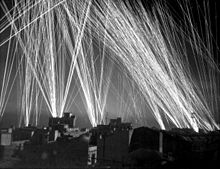
After the
During the War, large numbers of both Muslim and European Algerians served with the French Army. Algerian troops particularly distinguished themselves in the French Expeditionary Corps under General Juin during the Italian campaign of 1943 and in Operation Dragoon, the Allied invasion of southern France in 1944.
Andorra
Andorra remained politically neutral throughout the war but was used as a smuggling route by Axis Vichy French and Axis-aligned Spanish personnel.
Anglo-Egyptian Sudan
The condominium of
Another SDF battalion was part of
Antarctica

International competition extended to the continent of Antarctica during the World War II era, though the region saw no combat. During the prelude to war, Nazi Germany organised the 1938 Third German Antarctic Expedition to preempt Norway's claim to Queen Maud Land.[12] The expedition served as the basis for a new German claim, called New Swabia.[13] A year later, the United States Antarctic Service Expedition established two bases, which operated for two years before being abandoned.[14] Responding to these encroachments, and taking advantage of Europe's wartime turmoil, the nearby nations of Chile and Argentina made their own claims. In 1940 Chile proclaimed the Chilean Antarctic Territory in areas already claimed by Britain, while Argentina proclaimed Argentine Antarctica in 1943 in an overlapping area.
In response to the activities of Germany, Chile, Argentina, and the United States, Britain launched Operation Tabarin in 1943. Its objective was to establish a permanent presence and assert Britain's claim to the Falkland Islands Dependencies,[15] as well as to deny use of the area to the Kriegsmarine, which was known to use remote islands as rendezvous points. There was also a fear that Japan might attempt to seize the Falkland Islands. The expedition under Lieutenant James Marr[16] left the Falklands on 29 January 1944. Bases were established on Deception Island, the coast of Graham Land, and at Hope Bay. The research begun by Operation Tabarin continued in subsequent years, ultimately becoming the British Antarctic Survey.[17]
In the postwar period, competition continued among Antarctica's claimant powers, as well as the United States and Soviet Union. In the late 1950s, this competition would gave way to a cooperative international framework with the International Geophysical Year and the Antarctic Treaty.Antigua and Barbuda
Argentina
Before the start of World War II in
Australia
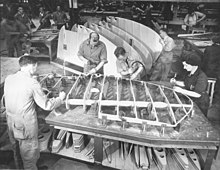
Australia was among the first countries to announce it was at war with Germany, on 3 September 1939. The Prime Minister, Robert Menzies considered that the British declaration legally bound Australia, and he announced a state of war between Australia and Germany as a direct consequence of the British declaration.[22]
More than one million Australian men served in the war out of a total population of around seven million. Although it was ill-prepared for war, the Australian government soon dispatched squadrons and personnel to serve with the
For the remainder of the war, the Australian war effort was concentrated in
Papua and New Guinea

What is now
During the war, civil administration in both territories ceased and the whole area was placed under martial law. Only a single battalion, the Papuan Infantry Battalion, was ever recruited from the native Papuan population. Many other people were recruited to bring supplies up to the front and carry injured Australian troops: the so-called Fuzzy Wuzzy Angels. Civil government was restored after the war, and in 1949 the two territories were united as the Territory of Papua and New Guinea.
See also Pacific Islands.
Bahamas
As part of the
The
See also Caribbean Islands.
Bahrain
The Sheikh of Bahrain declared war on Germany on September 10, 1939. On October 19, 1940, four Italian planes bombed Bahrain to destroy oil refineries supplying the Allies.[31] The raid caused minimal damage to the oil refineries but made the Allies increase the defense around Bahrain (being a UK protectorate).
Belgium
In 1936
Belgium's elected government fled the occupation, relocating to France and then London, where it established the
Postwar Belgium joined
Belgian Congo
The
The colonial government's demands on the Congolese population provoked strikes, riots and other forms of resistance. These were repressed, often violently, by the colonial authorities. The Congo's comparative prosperity during the conflict led to a wave of post-war immigration from Belgium, bringing the white population to 100,000 by 1950, as well as a period of industrialisation and urbanisation that continued throughout the 1950s.
Rwanda-Urundi
Belgium's mandate of Ruanda-Urundi consisted of the modern nations of Rwanda and Burundi. There, the war years were marked by the Ruzagayura famine. Though initially caused by a drought, the famine's effects were made worse by the Belgian war effort as authorities tried to send agricultural produce to the Congo to support the Allies. The famine killed between a fifth and a third of the colony's population and displaced many thousands more.[51]
Bhutan
Although Bhutan was under British suzerainty, it remained independent; and under the reign of Jigme Wangchuck the kingdom continued to maintain almost complete isolation from the outside world with only limited relations with the British Raj in India. Despite his policy of neutrality, upon the outbreak of the war the king sent the government of India a gift of 100,000 rupees as a gesture of friendship.[52]
Bolivia
Bolivia was one of many Latin American countries to declare war on Germany later on in the war, joining the Allies on 7 April 1943. It was one of the three countries to declare war in 1943, the others being Chile and Colombia. Shortly after war was declared, the President of Bolivia, Enrique Peñaranda, was overthrown in a coup. The new ruler, Gualberto Villarroel, had fascist and anti-Semitic leanings, but foreign pressure[clarification needed] compelled him to remain at peace and to suppress his more extreme pro-Nazi supporters. Bolivian mines supplied needed tin to the Allies, but with no coastline, the landlocked country did not send troops or warplanes overseas.[53]
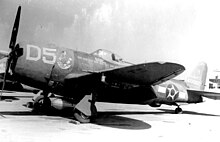
Brazil

Northeastern Brazil hosted at
Brazilian naval forces in the Battle of the Atlantic helped US and British Navies to patrol the South and Central Atlantic Ocean, combating Axis U-boats and raiders. In 1943, Allied naval forces sunk most of the Axis submarines which were active in the West of the South Atlantic, the U-199 among them. After this intense campaign, the South Atlantic became a lost battle to Germany.[58][59][60]
After two years of preparation, a complete infantry
British Borneo
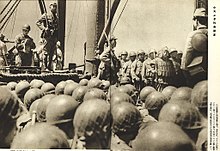
The Japanese invasion plan called for the British territories to be taken and held by the Imperial Japanese Army and the southern Dutch territory to be taken and held by the Imperial Japanese Navy. was captured.
British Honduras
See Caribbean Islands.
Bulgaria

After the Communist-dominated
Burma (Myanmar)
Many Burmese hoped to gain support of the Japanese in expelling the British, so that Burma could become independent.
Allied forces launched
Canada

- At the time of World War II, Newfoundland section.
On 10 September 1939, Canada likewise declared war on Germany,[67] this was the beginning of Canada's participation in the largest combined national effort in its history. Canada's military was active mainly in Italy,[68] Northwestern Europe,[69] and the North Atlantic.
Over the course of the war, 1.1 million Canadians served in the
Canadian forces deployed to the United Kingdom in 1939. One corps fought in the Italian campaign while the other fought in Northwest Europe beginning with the Normandy landings on 6 June 1944, invading Juno Beach. The 1st Canadian Army ended the war on German soil with five Canadian divisions and a host of allied formations under direct command.
During the war, Canada was subject to direct attack in the
The war had significant cultural, political and economic effects on Canada, including the conscription crisis. However, the war effort not only strengthened the Canadian economy but further established Canada as a major actor on the world stage.[75]
Caribbean Islands
Over the course of World War II, the United States assumed Britain's defense responsibilities in the Caribbean. In September 1940, the two countries agreed to the Lend-Lease Agreement (also called the
More than 50 percent of the supplies sent to Europe and Africa from the United States were shipped from ports in the Gulf of Mexico and passed through the Caribbean. One year after the Pearl Harbor attack, the United States Caribbean Defense Command reached a total of 119,000 personnel, half of them stationed in Panama to protect the canal from an anticipated Japanese attack. Meanwhile, the German Kriegsmarine inflicted massive damage on shipping in the Caribbean in 1942. By the end of that year, U-boats operating in the Caribbean had sunk 336 ships, at least half of which were oil tankers.[76]
Parts of the Caribbean had been colonized by countries that now came under Axis occupation. Aruba and Curaçao remained loyal to the Dutch government-in-exile, but because they housed valuable refineries that processed Venezuelan petroleum, they were placed under British protection. Both islands were subjected to German attacks in Operation Neuland. In 1942 they were transferred to the United States, which had also stationed troops in Surinam in 1941 to secure its bauxite mines.[77] Martinique and Guadeloupe came under the control of Vichy France. American and British pressure ensured that several French ships, including its only aircraft carrier, Béarn, remained interned at Martinique.[78] Thousands of refugees fled, many going to Dominica, while an anti-Vichy resistance movement grew.[77] The islands, along with French Guiana, switched to Free France in 1943.
See also this article's sections on Cuba, the Dominican Republic, Haiti, the Bahamas, and Puerto Rico.
Ceylon (Sri Lanka)
Ceylon (now known as Sri Lanka), was a British colony and a major Allied naval base. On 5 April 1942, over 300 aircraft from Japanese carriers bombed the island. Winston Churchill called it "the most dangerous moment" of World War II, because the Japanese wished to replicate a grander success of the attack at Pearl Harbor. British ships, however, were moved to Addu Atoll, Maldives Islands. Nevertheless, the British lost an aircraft carrier, two cruisers, and two destroyers, while the Royal Air Force squadrons on Ceylon suffered severe losses.
The
Following the Cocos Islands Mutiny, no Ceylonese combat unit was deployed in front-line combat, although Supply & Transport Corps troops were used in rear areas in the Middle East. The defences of Sri Lanka were beefed up to three Allied army divisions because the island was strategically important, as a producer of
Chile
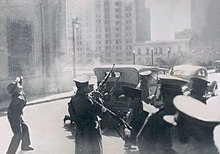
China

The
The war cooled China's formerly warm relations with Germany (see
Many of China's urban centers, industrial resources, and coastal regions were occupied by Japan for most of the war. China suffered a large death toll from the war, both military and civilian. The Chinese Nationalist army suffered some 3.2 million casualties, and 17 million civilians died in the crossfire. After the war, China gained one of the permanent seats on the United Nations Security Council.[82]
Although the Nationalists and Communists had cooperated to oppose the Japanese, once the war was over the
Colombia
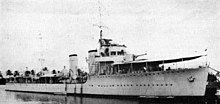
After the attack on Pearl Harbor, Colombia broke diplomatic relations with the Axis powers. Colombia provided the Allies with petroleum products. In 1943, the German submarine U-505 destroyed a Colombian schooner, which caused Colombia to declare a "status of belligerency" against Germany on 26 November 1943.[83]
The German ambassador left the country, and measures of control were implemented, including the internment of German citizens in designated areas. Photographs and reconnaissance airplanes belonging to the Colombian-German company
Comoros
Costa Rica
Left-wing reformist President Rafael Ángel Calderón Guardia was an ally of Franklin Roosevelt and hostile to Nazism. In 1940, it was reported that Calderón and Roosevelt had agreed to the construction of an American base on Cocos Island, Costa Rica's territory in the Pacific; however, the United States ultimately decided on a base in the Galápagos instead. Costa Rica joined the Allies on 8 December 1941, declaring war on Japan the day after the attack on Pearl Harbor, and on Germany and Italy shortly afterwards. While Costa Rica's small army of 500 men could not contribute directly to the fighting, Calderón's administration introduced wartime measures against people from Axis nations in the country, including property seizure and internment. Targets included Germans, Italians, and Spaniards, the last of whom were viewed as franquistas sympathetic to fascism.[85]
Cuba
President Federico Laredo Brú led Cuba when war broke out in Europe, though real power belonged to Fulgencio Batista as Chief of Staff of the army.[86] In 1940, Laredo Brú infamously denied entry to 900 Jewish refugees who arrived in Havana aboard the German oceanliner MS St. Louis. After both the United States and Canada likewise refused to accept the refugees, they returned to Europe, where many were eventually murdered in the Holocaust.[87] Batista became president in his own right following the election of 1940. He cooperated with the United States as it moved closer to war against the Axis. Cuba declared war on Japan on 8 December 1941, and on Germany and Italy on 11 December.[88]
Cuba was an important participant in the
Cyprus
The
Czechoslovakia
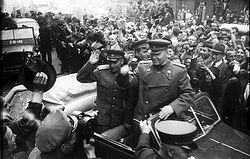
From 1940, a
Slovak Republic (Slovakia)
The newly founded Slovak Republic led by Jozef Tiso was proclaimed on March 14, 1939, allying with Nazi Germany and its armed forces participated in war against Poland and Soviet Union. Slovakia adopted Nazi antisemitic policy and paid Germany for deportation of its Jews. Trans-Olza was annexed by Germany following the Invasion of Poland, the Slovak National Uprising, commenced in August 1944 was suppressed by German forces at the end of October; partisans, however, continued fighting in the mountains until the war's end. In April 1945, the Red Army defeated the Germans and ousted Tiso's government, and restored the Czechoslovak state.[83]
Danzig
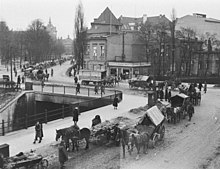
The Free City of Danzig, a semi-autonomous city-state under League of Nations protection, was predominantly German and had a Nazi government by 1936.[91] On 30 August 1939, Germany gave Poland an ultimatum demanding control of the city, provoking the Danzig crisis and the invasion of Poland on 1 September. The city-state aided Nazi Germany during the invasion. The Free City of Danzig Police and militia fought in the Battle of Westerplatte and the attack on the Polish post office in Danzig.[92] After the Polish campaign, Danzig was annexed to Germany. The Nazis subjected Danzig's Jewish and Polish minorities to the violence of the Holocaust and the Nazi crimes against the Polish nation. The Red Army occupied Danzig on 30 March 1945 and expelled its Germans; an estimated 290,800 had fled or been expelled from the city by 1950.[93] Gdańsk became part of Poland after the war.
Denmark
Denmark officially remained neutral from the outbreak of the war. Germany invaded without declaration of war as part of Operation Weserübung on 9 April 1940, and overwhelmed Denmark in a few hours of fighting.
The Danish government remained in office in Copenhagen until 1943 and signed the Anti-Comintern Pact. On 29 August 1943, the government resigned and dissolved, as a response to German demands for more concessions. Denmark was now under German military occupation. Civil affairs were handled by SS-general Werner Best.
On 4 May 1945, German forces in Denmark surrendered to the British army. Since the German commander of the eastern island of Bornholm refused to surrender to the Soviet Union, two local towns were bombed and the garrison forced to surrender. Bornholm remained under Soviet control until 1946.
Faroe Islands and Greenland
On 10 May 1940, the British invaded
Dominican Republic
The Dominican Republic declared war on Germany and Japan following the attacks of Pearl Harbor and the Nazi declaration of war on the U.S. It did not directly contribute with troops, aircraft, or ships, however 112 Dominicans were integrated into the U.S. military and fought in the war. In addition, 27 Dominicans were killed when German submarines sank four Dominican-crewed ships in the Caribbean.[94]
Dutch East Indies (Indonesia)

The rich petroleum resources of the Dutch East Indies were a prime objective of the Japanese military in its attack on the Allies from 7 December 1941. The
The period of the Japanese occupation was one of the most critical in Indonesian history. Initially, many Indonesians joyfully welcomed the Japanese as liberators from Dutch colonialism. The sentiment changed, however, as Indonesians realized that they were expected to endure hardships for the Japanese war effort. In Java and Sumatra, the Japanese educated, trained and armed many young Indonesians and gave nationalist leaders a political voice. In this way, the Japanese occupation created the conditions for Indonesian independence.[96]
In 1944–1945, Allied troops largely bypassed Indonesia. Therefore, most of the colony was still under Japanese occupation at the time of its surrender in August 1945. The Proclamation of Indonesian Independence was read within days of the Japanese surrender in the Pacific. The Indonesian National Revolution followed, winning independence for the country in 1949. A later UN report stated that four million people died in Indonesia as a result of the Japanese occupation.[97] About 2.4 million people died in Java from famine during 1944–45.[98]
Ecuador
Ecuador was one of several South American nations to join the Allies late in the war (joined against Germany on 2 February 1945), allowing the United States use of Baltra Island as a naval base.[99]
Egypt
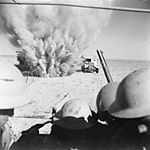
Britain had unilaterally recognized the independence of Egypt in 1922, but continued to occupy the country militarily, and to dominate it. By the Anglo–Egyptian Treaty of 1936, the British occupation was limited to the Suez Canal Zone, but it allowed British troops to re-occupy the rest of the country in time of war.
Egypt was of vital strategic importance because of the Suez Canal and Egypt's central geographical location. The Egyptian government supplied the British forces, but some engaged in secret negotiations with Germany about the prospect of Egypt's joining the Axis should the British be defeated in the
After British forces defeated the initial Italian invasion, Germany entered the North African theatre to save
El Salvador

From 1931 to 1944, El Salvador was ruled by the military dictator Maximiliano Hernández Martínez, an admirer of Hitler and Mussolini. Despite his personal admiration, Hernández Martínez declared war on both Japan (8 December 1941) and Germany (12 December 1941) shortly after the attack on Pearl Harbor due to El Salvador's strong economic ties with the United States. He removed Germans from the government and interned Japanese, German, and Italian nationals. The Second World War made Salvadorans weary of their dictatorship, and a general national strike in 1944 forced Hernández Martínez to resign and flee to Guatemala. Postwar, he was later killed in Honduras by a vengeful Salvadoran citizen.[100]
In 1937, during the rise of Nazism in Europe, Doctor Guerrero took over as president, until he was forced to leave in 1940 by the Nazis. Precisely after the
Once established in Geneva, Dr. Guerrero was visited by the Consul General of El Salvador in Switzerland, Colonel José Castellanos Contreras, who had fled from Germany, where he served as Consul until El Salvador broke relations with the Hitler regime.
Colonel Castellanos had already granted several visas to people of Jewish origin who were persecuted by the Nazis. However, now that it was part of a larger project: the handing over of false documents of Salvadoran nationality to people of Jewish origin. Castellanos then consulted Dr. Guerrero, who immediately agreed to the plan that saved the lives of thousands of Jews. According to the investigations, Dr. Guerrero would have contributed to writing the text of the document that was then given to them to save their lives.
Estonia
The August 1939 Molotov–Ribbentrop Pact between Nazi Germany and the Soviet Union left Estonia in the Soviet sphere of interest. The Soviet Union threatened Estonia with war if Estonia did not agree with "a mutual assistance pact", which would allow the Soviet troops to use several military bases in Estonia during a 10-year period. The Estonian government, convinced that a war against USSR would be inevitably lost, agreed on 28 September 1939. The Soviets conducted a coup d'état with the start of the full Soviet occupation of Estonia by the Red Army in June 1940, and a sham election was held under Soviet control. The new government took office and the Estonian Soviet Socialist Republic was proclaimed on 21 July 1940. The puppet state was formally accepted into the Soviet Union on 6 August. The legality of the annexation was not recognized by most Western countries and the Baltic states continued to exist formally as independent nations until they regained independence in 1991.[83]
Estonia was
Ethiopia
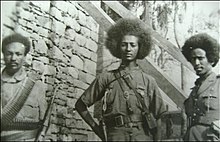
At the outbreak of the war, Ethiopia was under Italian occupation and Emperor Haile Selassie of Ethiopia was in exile in England trying in vain to obtain Allied support for his nation's cause. The Arbegnoch movement had begun its guerrilla war against the occupying Italian forces the day Addis Ababa fell in May 1936. Upon the emperor's flight into exile, remnants of Ethiopia's disbanded imperial army had transformed into guerrilla units. Urban city residents throughout the country formed underground movements to aid the Patriots as the overall population led a passive resistance campaign aimed at stifling Mussolini's economic agenda for the region. Throughout the occupation and into the beginning of the Second World War, the constant harassment of Italian columns and communication and supply lines reduced their fighting capabilities and their morale. A state of paranoia among Italian troops and civilians alike had sunk in as they became increasingly isolated from Rome.[citation needed] Fascist retaliation to Patriot attacks was brutal and often targeted the civilian population, which only further filled the ranks of the Patriots creating a cycle that led to the eventual demise of Mussolini's Italian East Africa.[102]
Britain's declaration of war against Italy reinvigorated the Patriot movement and paved the way for the final ousting of the Italians in Ethiopia and in the
Fiji
Fiji was a British colony during World War II. The Fiji Defence Force served with New Zealand Army formations, under the Allied Pacific Ocean Areas command. The Fiji Infantry Regiment fought in the Solomon Islands Campaign against the Japanese. Fiji became a major military sea port for convoy traffic between the U.S. and Australia. It was the closest reasonably safe route around the embattled Solomon Islands, a stopping-off point for troops and supplies being shipped to the Solomons, just to the north, and the closest protected harbor available to ships damaged around Guadalcanal. Fiji also constructed many facilities such as airfields for Allied bombing runs, barracks and training grounds.[103]
See also Pacific Islands.
Finland
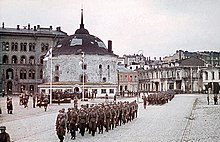
Finland was left to the Soviet sphere of interest in
To secure military support needed to stop the
France
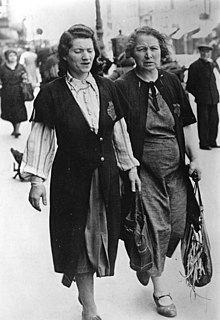
France was one of the original guarantors of Polish security and as such was one of the first countries to declare war on Germany. For several months, little fighting occurred in the Phoney War or drôle de guerre ("funny war"). On May 10, 1940, Germany began its attack on France. After six weeks of intense battling, the French government signed the Armistice of 22 June 1940.[105]
After the armistice, France was split into two parts, an
The
Vichy France
The Vichy regime remained officially neutral during the conflict but collaborated with Germany. Prime Minister
Free France
The Free French Forces (FFF) of the
In 1944, FFF soldiers numbered about 560,000 and in 1945, more than 1,300,000. The Resistance (forces of the interior), according to D. E. Eisenhower, played a role equal to 15 fighting divisions. The FFF and Resistance played a major role during the liberation of France.
French Equatorial Africa

The colonial federation rallied to the
French Somaliland
French West Africa
The Gambia
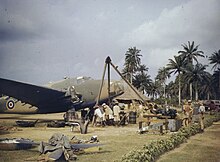
The
Germany

Nazi Germany, led by Adolf Hitler, was the primary Axis Power in the European Theatre. German forces instigated the war in September 1939 by invading Poland. Poland was divided with the Soviet Union. The Phony War ensued and in the spring of 1940 German forces invaded and conquered Denmark, Norway, France, Belgium, Luxembourg, and the Netherlands. Attempts to subdue the United Kingdom by air in the summer of 1940 failed and a planned invasion was called off. In the summer of 1941 Germany turned its forces east by invading the Soviet Union. The Eastern Front became the main theatre of war for the Germans. The invasion of the USSR had been delayed by campaigns in Greece and Yugoslavia, aimed at assisting floundering Italian forces. The Afrika Korps was similarly dispatched to the Western Desert to assist struggling Italian forces there, and German forces grew to an entire army group. Major defeats at Stalingrad in February 1943 and the destruction of Axis forces in North Africa shortly after are commonly thought to be the war's turning points. German forces fought on Sicily, and when Italy switched sides, German forces seized power, fighting a successful withdrawal and diverting Allied forces from Northwest Europe. Severe losses at Kursk in the summer of 1943 and during the Soviet summer offensives of 1944 shattered German fighting power, and Allied landings in Normandy and Southern France forced the Germans to fight on several fronts simultaneously. The surrender of the German forces between 4 May and 8 May 1945 signaled the end of the war in Europe.
German forces were very active at sea, primarily through its submarine force. The German air force provided effective tactical and logistical support until Allied air superiority was achieved by the middle of 1944. Strategic use of airpower failed and despite heavy aerial bombardment (and later, the V-1 and V-2 rockets) of the United Kingdom, failed to achieve lasting results.
Hitler's war aims included the destruction of the Jews of Europe, and at the Wannsee Conference in early 1942, a system of extermination was finalized which led to the Holocaust.
Austria
Austria became a full part of Nazi Germany in 1938 among popular acclaim during the Anschluss. About 1.2 million Austrians served in all branches of the German armed forces during World War II. After the defeat of the Axis Powers, the Allies occupied Austria in four occupation zones set up at the end of World War II until 1955, when the country again became a fully independent republic under the condition that it remained neutral. The four occupations zones were French, American, British, and Soviet, with Vienna also divided among the four powers. This paralleled the situation in post-war Germany.
Gibraltar
The
Gold Coast (Ghana)
Colonial troops from the
Greece
The government and the King
Throughout 1943, the guerrillas liberated much of the country's mountainous interior, establishing a free zone called "
With the advance of the Red Army through Eastern Europe in summer 1944, the German forces withdrew from the Greek mainland in October–November 1944, although many island garrisons were left behind and surrendered after the unconditional surrender on 8 May 1945. The returning government in exile, backed by British forces, soon clashed with EAM forces in Athens, beginning the Greek Civil War; a conflict that would last until 1949 and leave a divisive legacy.
Guatemala
Guatemala initially stayed out of World War II, with President Jorge Ubico declaring the country's neutrality on 4 September 1941. This pronouncement was reinforced five days later with another declaration. Ubico implemented strong prohibitions on Nazi propaganda in Guatemala, which had one of Latin America's largest German immigrant populations. Later, Guatemala moved into the Allied camp—on 9 December 1941, it declared war on Japan, and three days later, it declared war on Germany and Italy. Ubico permitted the United States to build an air base in the country.[120]
Unrest in Guatemala grew during the war years, culminating in the outbreak of the Guatemalan Revolution in June 1944. Ubico resigned in June following a general strike, and the new dictator that replaced him fell to a democratic popular revolution in October. The philosopher Juan José Arévalo won a presidential election held that December; he led Guatemala for the remainder of the war period.
Guyana
See Caribbean Islands.
Haiti
Honduras
Honduras was initially neutral in the war but joined the Allied side after the attack on Pearl Harbor. It declared war on Japan on 8 December 1941, and on Germany and Italy five days later. It contributed food and raw materials to the Allied war effort and did send troops, of whom 150 died. Due to this, the country began a series of air patrols using NA-16 model aircraft starting in 1942. German submarines also sank three Honduran ships throughout the war and one was captured by the Japanese navy. In addition to patrolling Honduran territory, Honduran airmen also flew in the vicinity of the Gulf of Mexico in joint support with other Latin American nations to prevent more ships destined for the United States from sinking[125]
Hong Kong
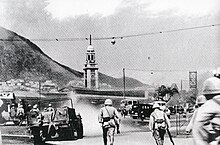
Hungary

Hungary was a significant German ally. It signed the Tripartite Pact on 20 November 1940, and joined in the invasion of the Soviet Union the next year. When, in 1944, the government of Regent Miklós Horthy wished to sign a ceasefire with the Allies, he was overthrown by the Nazis and replaced by a government run by the Hungarist Arrow Cross movement, which ruled the country until it was overrun by the Soviets in 1945.
Iceland
Iceland was a free state at the outbreak of war in personal union with the King of Denmark acting as head of state. After the German invasion of Denmark (1940), Iceland lost all contact with the King. British forces invaded Iceland on 10 May 1940, to secure bases for themselves and to deny Germany the same option. A small armed force was present, but obeyed orders not to resist the British. The British proceeded to arrest a number of German nationals, including the German consul, Werner Gerlach, and seize radio and telephone services.
Iceland's government formally protested the occupation, but provided the British with de facto cooperation. During the height of the occupation, 25,000 British soldiers were stationed in Iceland, compared to roughly 40,000 inhabitants of Reykjavík. On 7 July 1941, control of Iceland was transferred from Britain to the USA. The U.S. was not yet at war, but Iceland needed to be denied to the Germans.
Iceland experienced an economic boom during the occupation, since many Icelanders took jobs working for the foreigners, and some say that bretavinnan (roughly, the British Jobs) provided some of the successes of the post-war Icelandic economy. On 17 June 1944, with American encouragement, Iceland became a permanently independent republic, and it cut all ties with Denmark. Despite being occupied, Iceland remained officially neutral throughout the duration of the Second World War. Icelandic air bases such as at Keflavík were important to the Allied fight against the German U-boats in the Battle of the Atlantic.
With its small population, Iceland was in no position to raise any armed forces. The close cooperation between the Americans and the Icelanders led to Iceland's giving up neutrality and becoming a charter member of the
India

The
The labour of millions more Indians contributed to the Allied war effort. Poor working conditions and accidents such as the
An estimated 2.1–3 million, out of a population of 60.3 million, died of starvation, malaria and other diseases aggravated by malnutrition, population displacement, unsanitary conditions and lack of health care. Historians have frequently characterized the famine as "man-made", asserting that wartime colonial policies created and then exacerbated the crisis.[135]
While large sectors of Indian society lent their support to the war, including the
Andaman and Nicobar Islands
On 23 March 1942, Japanese forces invaded the Andaman and Nicobar Islands. In December 1943, the Japanese-sponsored Free India Movement (Azad Hind) was formed. The Andaman Islands were renamed Shaheed Islands, and the Nicobars were renamed Swaraj Islands. Andaman & Nicobar Islanders fought alongside the Japanese during this time. The islands were not reoccupied by the British until 6 October 1945.
Indochina
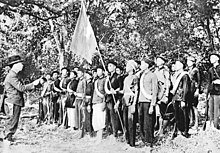
After the
During the Japanese occupation, Indochinese communists established a base in
The
Laos
In 1945 the Japanese occupied Vientiane in April.
Iran
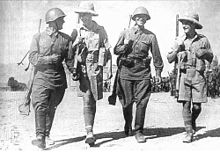
During the start of the war the Allies demanded that Iran remove German nationals from their soil, fearing they might be Nazi spies or harm the British-owned oil facilities, but Reza Shah refused, stating that they had nothing to do with the Nazis.
The Allies worried that Germany would look to neutral Iran for oil. Soon the Allies questioned themselves about Iranian neutrality and they gave Reza Shah a final warning to remove the German workers. He refused once again. In August 1941, the British and Soviet troops invaded Iran (
Iran provided a 'blue water' supply route to the Soviet Union via the port of
In September 1943, Iran declared war on Germany, which qualified it for membership in the United Nations (UN).
The Soviet Union fomented revolts among the
Iraq
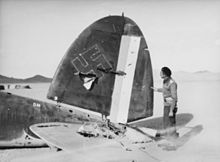
The new regime secretly began negotiations with the Axis powers. The Germans and Italians responded quickly and sent military aid by Luftwaffe aircraft to Baghdad via Syria. Indian troops consequently invaded in late April 1941 and reached Baghdad and RAF Habbaniyah in May. The Iraqi army attacked Habbaniyah but quickly capitulated and Rashid Ali fled the country. The United Kingdom urged Iraq to declare war on the Axis in 1942. British forces remained to protect the vital oil supplies. Iraq declared war on the Axis powers in 1943 after cutting diplomatic ties. Germany initially refused to accept the declaration, as they still recognised Rashad Ali as the legitimate government.[139] The Iraqi army played a role in protecting the logistic routes of the Allies, especially the military aids to the Soviet Union which used to arrive from Basra, Baghdad and Kirkuk. British and Indian operations in Iraq should be viewed in conjunction with events in neighbouring Syria and Persia.
Ireland
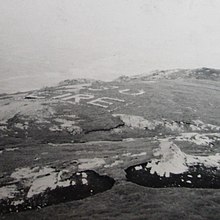
Ireland remained neutral throughout the war, the only member of the British Commonwealth to do so. The Emergency Powers Act 1939 gave sweeping new powers to the government for the duration, including internment, censorship, and government control of the economy. Internment of both Axis and Allied military took place in separate sections of the same camp. No.1 Internment camp, built by the British pre-1922, held republicans who had a suspected link to the IRA.[140]
Irish citizens were free to work abroad and join foreign militaries. By the end of the war, figures suggest that 70,000 men and women born in the State served in the British armed forces,
Some civilians were killed in the
In June 1940 British Major General
Italy

Fascist Italy had completed conquests (Ethiopia and Albania) prior to its entry into World War II. After the initially successful campaigns of Nazi Germany, Italy joined in the war in June 1940, planning to get a share of Allied territory with the defeat of France.
The Italians
The new royal government of Marshal
The royal government remained in control of the south and declared war on Germany; the military forces it still controlled joined the Allies in a position of
Italian East Africa

Benito Mussolini had formed Italian East Africa in 1936 by merging recently conquered Ethiopia with the older colonies of Eritrea and Somaliland.[151] On 10 June 1940, Mussolini declared war on Britain and France, which made Italian military forces in East Africa a danger to the bordering British and French colonies. The Comando Supremo (Italian General Staff) had planned for a war after 1942; in the summer of 1940 Italy was not ready for a long war or for the occupation of large areas of Africa.[152]
The
After the campaign, the victorious Allies dismantled Italian East Africa. The Anglo-Ethiopian Agreement restored Haile Selassie to the Ethiopian throne (see the section on Ethiopia). Somaliland and Eritrea were placed under British military administration. In 1945, during the Potsdam Conference, the United Nations granted Italy trusteeship of Italian Somaliland under close supervision, on condition that Somalia achieve independence within ten years.[154] In 1950 Eritrea was ceded to Ethiopia. Both British and Italian Somaliland became independent in 1960 soon after united as the Somali Republic.[155]
Jamaica
See Caribbean Islands.
Japan
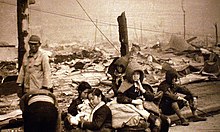
The
Kenya

During the war,
Fighting occurred in northern Kenya as part of the
Korea

Independence movements during the colonial era included the
The KLA failed to initiate Operation Eagle, a plan to liberate the Korean Peninsula by first attacking the capital region (
Formally, Japanese rule ended on 2 September 1945 upon the Japanese defeat in World War II in 1945. Postwar Korea was jointly occupied by Soviet and American forces, with political disagreements leading to the separation of the peninsula into two independent nations. This eventually escalated into the Korean War.
Latin America
Latvia
When the war began on September 1, 1939, Latvia declared its neutrality.
After the outbreak of
The first
Approximately 70,000 Latvians (both from Latvia and the Russian SFSR) were recruited, mostly through conscription, into national units in the Red Army (Latvian Riflemen Soviet Divisions). Also, a small fleet of Latvian ships, which did not return to their home country after the start of the Soviet occupation, became a part of the Allied merchant marine while flying the Latvian flag.[170]
Some Latvian personnel took an
Lebanon
Liberia
The importance of this resource led to significant improvement of Liberia's transport infrastructure and a modernisation of its economy. Liberia's strategic significance was emphasised when Franklin Roosevelt, after attending the Casablanca Conference, visited Liberia and met President Edwin Barclay. Despite its assistance to the Allies, Liberia was reluctant to end its official neutrality and did not declare war on Germany until 27 January 1944.[83]
Libya
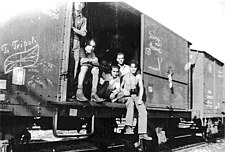
The coastal parts of
Libya saw some of the fiercest fighting of the
In February 1943, retreating German and Italian forces abandoned Libya and withdrew to Tunisia, permanently ending Italian rule. The Free French occupied Fezzan in 1943. At the close of World War II, Britain and France collaborated with local resistance in the Allied administration of Libya. In 1951, the Allies ceded power to Idris, now king of an independent Libya.[178]
Liechtenstein
After the end of
When war broke out, Franz Joseph kept the principality out of the war and relied upon its close ties to Switzerland for its protection.[181] The neutrality of the country itself was never violated, but the House of Liechtenstein never recovered its landholdings outside the principality, including its former seat in Lednice–Valtice.[180] The country took in some 400 Jewish refugees from occupied Europe and granted citizenship to some others, mostly people of means who were able to pay.[181] Jewish laborers at a concentration camp in Strasshof were hired out to work on estates belonging to the princely family.[181] In 1945 Liechtenstein gave asylum to nearly 500 Russians of the pro-Axis First Russian National Army. It refused Soviet demands to repatriate them, and most eventually resettled in Argentina.[182]
The National Socialist "German National Movement in Liechtenstein" was active but small. It called for unification with Germany and the expulsion of Liechtenstein's Jews.[183] In March 1939, the party attempted a coup that ended in total failure, its leaders having fled or been arrested.[183] The organization was formed anew in 1940 but did not gain any power. Its publication Umbruch was banned in 1943 and its leader was convicted of high treason after the war.[183]
Lithuania
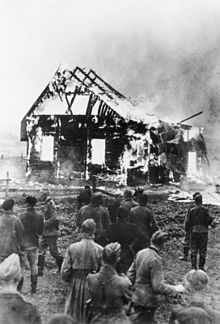
As a result of
Some Lithuanians sided with Germany after Hitler eventually invaded the Soviet Union in the hopes of restoring Lithuania's independence. Some collaborators were
At the end of the war, the subsequent
Luxembourg
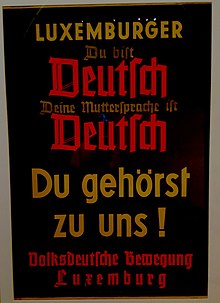
When Germany invaded France by way of the Low Countries in the spring of 1940, it also
The exiled Luxembourgish government meanwhile fled to France and then Portugal before establishing itself in London for the remainder of the war, while Grand Duchess Charlotte settled in Montreal.[187] The exiled government committed its very limited resources to the Allied war effort, signing the Declaration of St James's Palace and Declaration by United Nations. It also formed the agreement that created the Benelux customs union with the exiled governments of Belgium and the Netherlands.[188]
Some Luxembourgers collaborated with Nazi Germany or were drafted into the German armed forces. A total of 12,000 Luxembourgers served in the German military, of whom nearly 3,000 died during the war.[189] Others joined the Luxembourg Resistance. The general strike of 1942 was an act of passive resistance that mobilized a large portion of the population and led to the execution of 21 leaders.[189] American forces liberated the capital in September 1944, but the country continued to see combat. Luxembourg Resistance fought German forces in the Battle of Vianden in November, and the Battle of the Bulge was fought in the country between December and January.[190]
Madagascar

In May 1942, the British and several other Allied forces launched an invasion of Madagascar, seeking to protect its position as a link in Allied shipping and deny its use to the Axis. The northern naval base at Diego Suarez quickly surrendered. That September, newly arrived troops from East Africa, South Africa, and Northern Rhodesia launched an offensive to capture the rest of the island. British forces took the capital Tananarive in late September; on 8 November, the last Vichy forces surrendered. The British handed the island over to Free France in 1943, under whose control it remained for the rest of the war.
Malaya
Malaya was under British rule before the war began. It was occupied by Japan in 1942 through 1945. The Malayan Communist Party became the backbone of the Malayan Peoples' Anti-Japanese Army. [citation needed] The British Forces in Malaya fled to Singapore, where they would eventually be defeated. After the war, the British Military Administration of Malaya took over the country.
The 4 Malay states of Kedah, Perlis, Kelantan and Terengganu were annexed by Thailand, which was under a Fascist Regime and aligned to the Axis Powers. These territories were gifted by Japan, as they had occupied Malaya almost 2 years prior. All 4 states were given back to Malaya after the Japanese Surrender.
Maldives
During World War II, the
The Maldives were also a victim to massive resource shortages, notably economy and food-wise. Most food was imported into the country by boat during the war, and the nation relied on local fishing in the islands. This was commonly known as the great famine in the Maldives.[193]
Malta
The fortitude of the population under sustained air raids and a naval blockade, which almost saw them starved into submission, won widespread admiration, with some historians dubbing it "The Mediterranean
Manchukuo
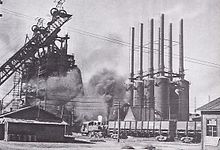
Established in 1931 as a puppet state of Japan, the Empire of
Mauritius
During the Second World War, the Mauritius Territorial Force was expanded to two battalions and renamed the Mauritius Regiment.[196] The 1st Battalion went to Diego Suarez, Madagascar, in December 1943 to relieve imperial forces who had captured the island in the Battle of Madagascar. Shortly after landing, the battalion mutinied due to poor conditions and because they had been told they would not leave Mauritius. Disarmed by the King's African Rifles, 300 soldiers were arrested, but only 6 remained imprisoned by 1946.[197] Mauritius also had a home guard formation, the Mauritius Defence Force of 2,000 men, and a naval Coastal Defence Force.[198]
Mengjiang
Mengjiang was established in Inner Mongolia as a puppet state of Japan, and contributed troops which fought alongside the Japanese in China. It ceased to exist following the Soviet invasion in 1945.
Mexico
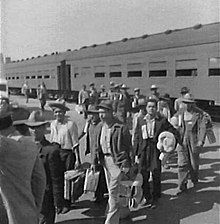
Mexico entered World War II in response to German attacks on Mexican ships. The
A large part of Mexico's contribution to the war came through an agreement January 1942 that allowed Mexican nationals living in the United States to join the American armed forces. As many as 250,000 Mexicans served in this way.
World War II helped spark an era of rapid industrialization known as the
Monaco
While
Mongolia

During the war,
The Soviet–Japanese Neutrality Pact of 13 April 1941 recognized the neutrality of Mongolia and its place with the Soviet sphere of influence. Its geographical situation made it a buffer state between Japanese forces and the Soviet Union. In addition to keeping around 10% of the population under arms, Mongolia provided supplies and raw materials to the Soviet military and financed several units, and half million military trained horses.
Mongolian troops took part in the
For Mongolia, the most important result of World War II was the recognition of its independence by China, American consent having been given with the
Morocco
Most of
A small area in northern Morocco,
Nauru
Nauru was administered by Australia under a League of Nations mandate. Nauru was shelled by a German surface raider in December 1940, aiming to incapacitate its phosphate mining operations (this action was probably the most distant military activity carried out by Germany during the entire war). Phosphates are important for making ammunition and fertilizers. [citation needed]
Nauru was occupied by Japan from 1942 to 1945, and was the target of shelling by American battleships and cruisers, and aerial bombing by the Allies. For example, Nauru was bombarded by the American battleships
Nepal
The
Besides RNA troops, Nepalese fought in the British Indian
Netherlands
Like the Belgians, the
New Zealand
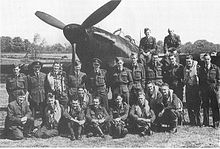
New Zealand declared war on 3 September 1939, backdating the date to the time of Britain's declaration.
- "With gratitude for the past and confidence in the future, we range ourselves without fear beside Britain. Where she goes, we go; where she stands, we stand. We are only a small and young nation, but we march with a union of hearts and souls to a common destiny."[213]
New Zealand sent one Army division that served in
New Zealand fought in the Pacific War through warships of the Royal New Zealand Navy, the Royal New Zealand Air Force (RNZAF), and independent army brigades, such as on Vella Lavella. While New Zealand's home islands were not attacked, the casualty rate suffered by the military was the worst per capita of all Commonwealth nations, except for Great Britain.[citation needed]
In the
Newfoundland

During World War II the
Newfoundlanders were encouraged to enlist in the large armed forces of the
Newfoundland was directly attacked by German forces when U-boats attacked four Allied ore carriers and the loading pier at Bell Island. The cargo ships S.S. Saganaga and S.S. Lord Strathcona were sunk by the German submarine U-513 on 5 September 1942, and the S.S. Rosecastle and P.L.M. 27 were sunk by the German submarine U-518 on 2 November 1942. German troops were landed in Labrador to establish weather stations.
Nicaragua
During the war,
Nigeria
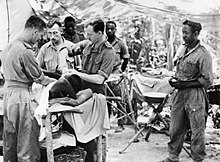
During World War II, three battalions of the
Northern Rhodesia (Zambia)
Norway

Norway remained neutral until it was invaded by Germany on 9 April 1940, as part of Operation Weserübung. The Norwegian government fled the capital and after two months of fighting went to Britain and continued the fight in exile.
The Norwegian Shipping and Trade Mission (
After the occupation, the Germans began producing heavy water in Norway. After commando raids and bomber attacks, the Germans decided to move heavy water supplies to Germany. The Allies maintained a deception of a planned invasion of Norway. As a result, additional German forces were held there to repel any attempts. In 1944, Finnmark was liberated by the Soviet Union, and (together with the northern parts of Troms) totally destroyed by the retreating Nazis. German forces surrendered on 8 May 1945.
Norway declared war on Japan on 6 July 1945, with reciprocal effect dating back to 7 December 1941.[219] The delay was because it had been impossible for the parliament to convene during the German occupation.[220] Several hundred Norwegian sailors died when their ships were sunk by Japanese forces or during subsequent captivity.[220] After the war, Norway became one of the founding members of NATO.
Nyasaland (Malawi)
Throughout the war, the
Many Nyasas fought for the British, primarily as
Oman
The Sultan of Oman declared war on Germany on September 10, 1939. During the Second World War, Great Britain recognized the strategic importance of Oman's geographical location by expanding facilities throughout the country. A new airfield was built on Masirah Island, which, from 1943 onwards, housed No. 33 Staging Post. In 1943, both Masirah and Ras Al-Hadd became Royal Air Force stations in their own right. Units of No. 2925 Squadron of the RAF Regiment guarded these bases while the marine craft was based in Oman to perform air-sea rescue duties.[225]
Pacific Islands
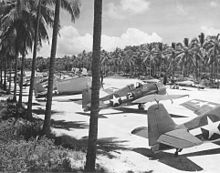
The population, culture and infrastructure of
The Pacific Islands then experienced military action, massive troop movements, and resource extraction and building projects as the Allies pushed the Japanese back to their home islands.[230] The juxtaposition of all these cultures led to a new understanding among the indigenous Pacific Islanders of their relationship with the colonial powers. In communities that had very little contact with Europeans before the war, the sudden arrival and rapid departure of men and machines spurred the growth of so-called "cargo cults" in parts of Melanesia,[231][232] such as the cult of John Frum that emerged in the New Hebrides (modern Vanuatu).
Palestine
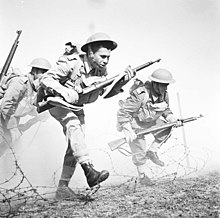
Since Nazi Germany was seen as a greater threat,
During the
In order to maintain the status quo ante bellum between the Jews and the Arabs, the British instated a policy of equal recruitment from both groups to the
On 3 July 1944, Britain agreed to allow the Jews to fight against the Nazis directly and not just in a supportive role. Thus the three Jewish battalions of the Palestine Regiment together with the 200th Field Regiment were reorganized under the aegis of the Jewish Brigade, which would see action in Italy.[236]
At the start of the war, approximately a thousand German nationals residing in Palestine known as
Panama
The small
Paraguay
Paraguay's authoritarian government under Higinio Morínigo was sympathetic to the Axis powers early in the war; the country's large German community, in particular, were supporters of Nazism, as well as most of the Paraguayan population.[238] Serious thought was given to joining the war on Germany's side, but United States President Franklin D. Roosevelt avoided this by providing aid and military hardware in 1942. Paraguay declared war on Germany on February 2, 1945, by which time the war was almost over and many Paraguayans joined the Brazilian air force for fighting the Axis Powers.[239]
Peru
Philippines
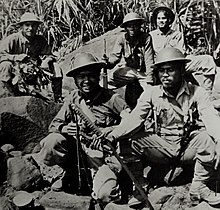
In 1941, the
Despite the official surrender, there was a significant
Poland

The Second World War started in September 1939, as
Portugal
For the duration of World War II, Portugal was under the control of the dictator António de Oliveira Salazar. Early in September 1939, Portugal proclaimed neutrality to avoid a military operation in Portuguese territory. This action was welcomed by Great Britain. Germany's invasion of France brought the Nazis to the Pyrenees, which increased the ability of Hitler to bring pressures on Portugal and Spain.
Following the Nazi invasion of the Soviet Union, which cut off their supply of tungsten metal, Germany sought tungsten from Portugal. Salazar attempted to limit their purchases, and in late 1941, German U-boats attacked Portuguese ships. In January 1942 Salazar signed an agreement to sell tungsten to Germany. In June 1943, Britain invoked the long-standing Anglo-Portuguese Alliance requesting the use of the Azores, to establish an air force and naval air base. Salazar complied at once. The Allies promised all possible aid in the event of a German attack and guaranteed the integrity of Portugal's territorial possessions. In 1944, Portugal declared a total embargo of tungsten shipments to Germany. Germany protested but did not retaliate.
Lisbon became a safe-haven to a scattering of
Portuguese Macau
Although the Japanese military invaded and occupied the neighboring British colony of Hong Kong in 1941, they initially avoided direct interference in the affairs of Macau. It remained a neutral territory, belonging to Portugal, but Portuguese authorities lacked the ability to prevent Japanese activities in and around Macau. In 1943, Japan ordered the government of Macau to accept Japanese advisors. The limited Portuguese military forces at Macau were disarmed, although Macau was never occupied.
Portuguese Timor (East Timor)
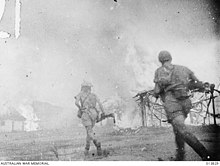
In early 1942, Portuguese authorities maintained their neutrality, in spite of warnings from the Australian and Dutch East Indies governments that Japan would invade. To protect their own positions in neighboring Dutch Timor, Australian and Dutch forces landed in Portuguese Timor and occupied the territory. There was no armed opposition from Portuguese forces or the civilian population. However, within a matter of weeks, Japanese forces landed but were unable to subdue substantial resistance, in the form of a guerrilla campaign launched by Allied commandos and continued by the local population. It is estimated that 40,000–70,000 Timorese civilians were killed by Japanese forces during 1942–45.[242]
Qatar
Qatar was a
Romania

With the entry of Soviet troops into Romania and a
After the war, Romania forcibly became a
Samoa
Samoa sent many troops to fight with the
When the American armed forces entered Samoa, using it as a port, four
See also Pacific Islands.
San Marino
Ever since the times of
Saudi Arabia
Sierra Leone
Freetown served as a critical convoy station for the Allies.
Singapore
Slovakia
Slovakia was part of Czechoslovakia during World War II. See this article's section on Czechoslovakia in general, and its subsection on the Slovak Republic in particular.
Solomon Islands

The impact of the war on islanders was profound. The destruction, together with the introduction of modern materials, machinery and Western material culture, transformed traditional ways of life. Some 680 islanders enlisted in the British Solomon Islands Protectorate Defence Force, while another 3,000 worked as labourers in the Solomon Islands Labour Corps.[247] The experiences of Corps members affected the development of the Pijin language and helped spark the postwar political movement Maasina Ruru.[248][249] During the war, the capital of Tulagi was damaged, while the Americans did much to develop the infrastructure around Henderson Field on Guadalcanal. After the war, this evolved into the new capital, Honiara.[250]
See also Pacific Islands.
South Africa

As a member of the British Commonwealth, the Union of
Southern Africa (Botswana, Lesotho, and Eswatini)
The so-called High Commission Territories of
Southern Rhodesia (Zimbabwe)
Soviet Union
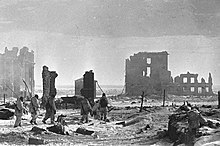
The
On June 22, 1941, Nazi Germany launched a massive surprise attack on the Soviet Union. Soviet forces took heavy losses, but this Eastern Front fighting would inflict on German forces about half of their military casualties over the course of the war.[255][256] After an initial devastating advance, the Wehrmacht suffered its first defeat in war at Moscow. The Germans and their allies tried in 1942 to advance southward, to the Caucasus. After six months of fighting, they suffered a pivotal defeat at Stalingrad. In late 1943, in the wake of Battle of Kursk, the Soviet Red Army gained the initiative with a series of major victories. After the Allies opened a second European front with the June 1944 landings in France, the USSR was able to push the Germans back.[257][258][259][260] Soviet forces advanced into Eastern Europe during 1944 and into Germany in 1945, concluding with the Battle of Berlin. The war against the USSR inflicted loss of lives (both civilian and military), on a scale greater than any countries in the war. Following the end of the war in Europe and the American atomic bombing of Hiroshima, the USSR joined the war against Japan. The Soviet Union, as one of the main victors, gained one of the permanent seats in the United Nations Security Council. After the war, the Soviet sphere of influence was widened to cover most of Eastern Europe, formalized in the Warsaw Pact. The Soviet Union came to be considered one of the two superpowers of the Cold War.[261]
Armenian SSR (Armenia)
Armenia participated in the Second World War on the side of the Allies under the Soviet Union. Armenia was spared the devastation and destruction that wrought most of the western Soviet Union during the Great Patriotic War of World War II. The Nazis never reached the South Caucasus, which they intended to do in order to capture the oil fields in Azerbaijan. Still, Armenia played a valuable role in aiding the allies both through industry and agriculture. An estimated 300–500,000 Armenians served in the war, almost half of whom did not return.[262] Armenia thus had one of the highest death tolls, per capita, among the other Soviet republics.
One hundred and nineteen Armenians were awarded with the rank of
Azerbaijan SSR (Azerbaijan)
Azerbaijan played a crucial role in the strategic energy policy of the Soviet Union since much of the petroleum needed on the
Baku was the primary strategic goal of the right flank of Germany's 1942
Byelorussian SSR (Belarus)
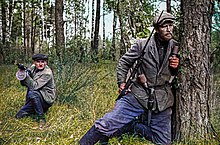
During WWII, Belarus was part of the Soviet Union as the
Georgian SSR (Georgia)
Although the Axis powers never penetrated the Georgian Soviet Socialist Republic, Soviet Georgia contributed to the war effort almost 700,000 officers and soldiers (about 20% of the total 3.2–3.4 million citizens mobilized), of which approximately 300,000 were killed. 137 Georgians were awarded Hero of the Soviet Union, the most numerous recipients of this award in the Caucasus.[267][268] The country was also a vital source of textiles as well as an important manufacturer of warplanes.[citation needed]
Around 30,000 Georgians, both captives and volunteers, fought for the Germans in units such as the
Ukrainian SSR (Ukraine)
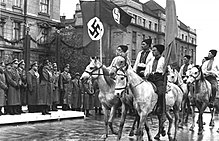
Before the German invasion, Ukraine was a
Those Ukrainians who remained at times welcomed the Germans as liberators. Those who collaborated with the German occupiers did so in various ways including participating in the local administration, in the
Spain
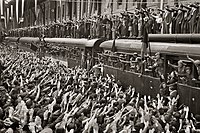
Italian and German intervention had aided the Franco government in the recent Spanish Civil War, but Franco and Hitler did not achieve an agreement about Spanish participation in the new war. Galicia became an alternate source of tungsten for the Reich. Despite its non-belligerency, Spain sent volunteers to fight against the Soviet Union in the form of the Blue Division. As the Allies emerged as possible victors, the regime declared neutrality in July 1943. Removal of Spanish troops from the Eastern Front was completed in March 1944.
Spain did make plans for defence of the country. Initially, the mass of the Spanish army was stationed in southern Spain in case of Allied attack from Gibraltar during 1940 and 1941. However, Franco ordered the divisions to gradually redeploy in the Pyrenees as Axis interest in Gibraltar grew. By the time it became clear that the Allies were gaining the upper hand, Franco had amassed all his troops on the French border and was assured that the Allies did not wish to invade Spain.
St. Lucia
See Caribbean Islands.
Suriname
In 1940, Suriname was a colony of the Netherlands. At the start of the
Suriname was a major producer of
The border with
Swaziland (Eswatini)
In exchange for greater Swazi autonomy from the British, King Sobhuza II gathered a few thousand Swazi volunteers to fight with the Allies in the war. Swazi soldiers served in the Western Desert campaign and the Invasion of Italy.
Sweden
Sweden maintained neutrality throughout the war, though some Swedish volunteers participated in the Winter War and in the Continuation War against the Soviet Union.
After Denmark and Norway were invaded on 9 April 1940, Sweden and the other remaining Baltic Sea countries became enclosed by Nazi Germany and the Soviet Union, then on friendly terms with each other as formalized in the Molotov–Ribbentrop Pact. The lengthy fighting in Norway resulted in intensified German demands for indirect support from Sweden, demands that Swedish diplomats were able to fend off by reminding the Germans of the Swedes' feeling of closeness to their Norwegian brethren. With the conclusion of hostilities in Norway this argument became untenable, forcing the Cabinet to give in to German pressure and allow continuous (unarmed) troop transports, via Swedish railroads, between Germany and Norway. Throughout the war, Sweden supplied Germany with iron ore, which they desperately needed to produce weapons.
Switzerland
Switzerland intended to be a neutral power during the war, but Axis threats and military mobilizations towards its borders prompted the Swiss military to prepare for war. Following the German invasion of Poland on 1 September 1939, this country was completely mobilized within three days. An invasion of Switzerland, codenamed Operation Tannenbaum was planned for 1940, but Hitler decided it would be a waste of resources. Unlike the Netherlands, Belgium, and other western European nations that had easily fallen under German maneuver warfare, Switzerland had a strong military and mountainous terrain offering defenders the traditional advantage of high ground in mountain warfare.
Despite its neutrality, Switzerland was not free from hostilities. Early in the war, Swiss fighters shot down German aircraft for violating Swiss air space. Counting both sides, hundreds of aircraft, such as those with battle damage, landed in Switzerland and were interned at Swiss airports and their crews held until the end of the war. Allied airmen were interned, in some cases contrary to Swiss law, and some were reportedly subjected to abuse in
Syria
In June 1941,
Tanganyika (Tanzania)
After the United Kingdom declared war, the British forces in Tanganyika were ordered to intern the German males living in the territory out of fear that they would try to help the Axis. Some of the Germans living in Dar es Salaam attempted to flee the country, but they were stopped and later interned by a small group of Tanganyikan soldiers and British officers that included Roald Dahl.[280]
During the war about 100,000 people from Tanganyika joined the Allies.
Tibet
Tibet was a de facto independent state that lacked international recognition.[284] It remained neutral throughout the war. The 14th Dalai Lama, Tenzin Gyatso, was enthroned by the Ganden Phodrang government at the Potala Palace in 1939. Tibet established a Foreign Office in 1942, and in 1946 it sent congratulatory missions to China and India related to the end of the war.[285] Its era of independence ended after the Nationalist government of China lost the Chinese Civil War and the People's Liberation Army entered Tibet in 1950.
Thailand
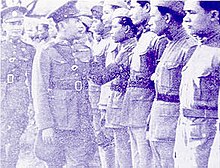
Japanese victory in the
Tonga
By 1939, Tonga was a
Transjordan
The Emirate of Transjordan was a British mandate territory, and the Transjordanian forces were under British command during the war.
Trinidad and Tobago
See Caribbean Islands.
Tunisia

Tunisia was a
Allied forces landed in Algeria with Operation Torch on 8 November 1942. Beginning on 10 November, the British First Army under Kenneth Anderson began to advance toward Tunis. For the next six months, Tunisia was a battlefield as Axis and Allied forces fought on northern and southern fronts. In February 1943 the Axis won a victory at the Battle of Kasserine Pass, the first major engagement involving American troops, but the Operation Ochsenkopf offensive at the end of the month failed to stop the Allied advance. The Battle of Longstop Hill cleared the road to Tunis, which fell on 7 May. All Axis forces in Tunisia surrendered in the following days.
Following the recapture of Tunis, Free France took control of the country. Charles Mast served as the Resident General for the remainder of the war. The Free French accused Moncef Bey of collaborating with the Vichy Government and deposed him.[293] From Tunisia, the Allies launched Operation Husky, the invasion of Sicily, in July 1943.
Turkey
Turkey was an important producer of
The main theme of
It is noteworthy that in the March 8, 1943 entry in the
Tuva
The
United Kingdom
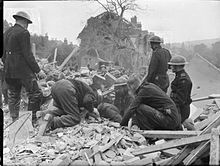
The
While Nazi Germany never attacked Britain with ground forces, it subjected the country to heavy air attacks in the Battle of Britain of 1940, which was won by the Royal Air Force. Nightly attacks of the Blitz continued until mid-1941, which killed 40,000 people[297] and prompted evacuations of major urban centres, but achieved none of Germany's strategic objectives.[298] The economy of Britain was re-oriented to military production.[299] Initiatives such as the Women's Land Army boosted food production, while a rationing program regulated consumption.
Britain entered the
Channel Islands
The Channel Islands are self-governing Crown dependencies off the coast of France, and were the only British territory to be occupied by Germany during the War. The islands are dependent on the United Kingdom for their defence and foreign relations. In 1940, the British government demilitarised the islands, and they were subsequently occupied by German forces. Strong German defences were set up, but the Islands were not assaulted except by occasional hit-and-run commando raids. German forces surrendered at the end of the war. Almost all the Jewish people fled the islands before the German occupation; some who remained were deported to extermination camps.[301]
Isle of Man
The Isle of Man is a self-governing Crown dependency external to the United Kingdom. Its foreign relations and defence, however, are the responsibility of the government of the UK. During the Second World War, the Isle of Man had a detention camp for Axis citizens and suspected sympathisers, including members of the British Union of Fascists and the Irish Republican Army.[citation needed] A naval base, radar network and training stations were also established on the island.
"The Captain", a 1967 WWII novel by Dutch writer Jan de Hartog, features a Royal Navy captain originating from the Isle of Man who takes great pride in his island, and who eventually goes down, heroically defending a naval convoy under his charge against an overwhelming attack by a U-boat "wolf pack".
United States
A sense of having been tricked into World War I led Congress, with strong public opinion backing, to pass the
Inside the United States, every aspect of life from politics to personal savings was put on a wartime footing. The country directed its massive industrial production to the war effort as what President Roosevelt called "the
American Samoa
Native American nations
25,000 Native Americans in World War II fought actively: 21,767 in the Army, 1,910 in the Navy, 874 in the Marines, 121 in the Coast Guard, and several hundred Native American women as nurses. As sovereign nations, the tribes joined the war alongside the United States with their citizens enlisting in the U.S. Armed Forces.[303]
The
Puerto Rico
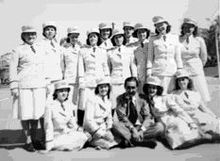
More than 65,000 Puerto Ricans served in the United States armed forces during World War II. Some guarded American installations in the
Borinquen Army Airfield (Ramey Air Force Base), was established in Puerto Rico in 1939.[307] In 1940, President Roosevelt ordered the construction of a major naval base to serve as "the Pearl Harbor of the Atlantic." Roosevelt Roads Naval Station grew into a major facility but was scaled back after the defeat of Germany. The naval station remained in use until 2003, when it was shut down.[308][309]
Uruguay
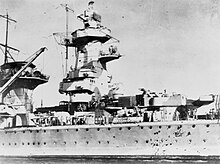
Neither side of the conflict acknowledged the exclusion zone, and in December, British warships and the German warship Admiral Graf Spee fought the Battle of the River Plate in the zone. This prompted a joint protest from several Latin American nations to both sides. (Admiral Graf Spee took refuge in Uruguay's capital, Montevideo, claiming sanctuary in a neutral port, but was later ordered out.) In early 1942, President Baldomir broke off diplomatic relations with the Axis Powers. On 15 February 1945, near the end of the war, Uruguay dropped its neutrality and joined the Allies, and declaring war on Germany and Japan.
Vatican City
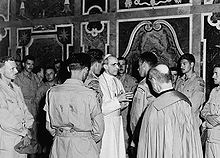
Vatican City, the smallest autonomous country in the world at 0.44 km2 (0.16 sq mi, little more than 100 acres), remained unoccupied throughout the war and its small military did not engage in combat. Pope Pius XII allegedly supported resistance efforts in secret, issued public statements against racism, and attempted to broker peace before the outbreak of total war. However, as Cardinal Eugenio Pacelli, he signed the very first treaty negotiated by Nazi Germany when it came to power in 1933, the Reichskonkordat, on behalf of Pope Pius XI (a treaty that remains in force).[citation needed] The Vatican City was also bound by the Lateran Treaty with Italy, requiring the Vatican and the Holy See to remain politically neutral, which Pius XII successfully maintained throughout the war.
Venezuela
After the attack on Pearl Harbor, Venezuela severed diplomatic relations with Italy, Germany, and Japan, and produced vast oil supplies for the Allies. It maintained a relative neutrality until the last years of war, when it finally declared war on Germany and the rest of the Axis countries.[citation needed]
Yemen
The
Yugoslavia

The Axis Powers occupied
Independent State of Croatia
The
Nedić's Serbia
Nedic's Serbia was a puppet state installed by Nazi Germany. Unlike the puppet state Independent State of Croatia, the regime in the occupied Yugoslavia was never accorded status in international law and did not enjoy formal diplomatic recognition on the part of the Axis powers.[315] The regime enjoyed some support.[316] Serbia became the second country in Europe, following Estonia,[317][318] to be proclaimed Judenfrei (free of Jews).[319][320][321][322][323]
Kingdom of Montenegro
The Kingdom of Montenegro was an occupied territory under
See also
- Lists of World War II topics
- Diplomatic history of World War II
- Declarations of war during World War II
- Military production during World War II
- World War II casualties
References
- ISBN 9781982164003.
- ^ Sainsbury, Keith (1986). The Turning Point: Roosevelt, Stalin, Churchill, and Chiang Kai-Shek, 1943: The Moscow, Cairo, and Teheran Conferences. Oxford: Oxford University Press.
- ^ Dupree, Louis: Afghanistan, pages 477–478. Princeton University Press, 1980
- ^ What Did Afghanistan Do In World War 2? | Central Asian Neutrality? 1939-1947, retrieved 2024-01-06
- ^ Ali, Tariq (30 November 2001). "The king of Greater Afghanistan; A German dispatch from 1940 shows Zahir Shah's true colours". Irish Independent. Retrieved 2016-11-29.
- ^ "EX-KING AMANULLAH NOW WORKS FOR HITLER". Argus (Melbourne, Vic. : 1848 – 1957). 1941-05-24. p. 4. Retrieved 2019-08-29.
- ISSN 0362-4331. Retrieved 2019-08-29.
- ISBN 9780674286092.
- ^ Cernuschi, Enrico. La resistenza sconosciuta in Africa Orientale
- OCLC 494123451. Retrieved 7 September 2017.
- ISBN 0-7195-6162-0.
- ^ Widerøe, Turi (2008). "Annekteringen av Dronning Maud Land". Norsk Polarhistorie (in Norwegian). Archived from the original on 24 September 2015. Retrieved 15 July 2011.
- ^ D. T. Murphy, German exploration of the polar world. A history, 1870–1940 (Nebraska 2002), p. 204.
- ^ Bertrand, Kenneth J. (1971). Americans in Antarctica 1775–1948. New York: American Geographical Society.
- ^ "About – British Antarctic Survey". www.antarctica.ac.uk. Retrieved 25 March 2018.
- ^ "Scott Polar Research Institute, Cambridge » Picture Library catalogue". www.spri.cam.ac.uk. Retrieved 25 March 2018.
- ^ "Operation Tabarin overview". British Antarctic Survey – Polar Science for Planet Earth. British Antarctic Survey. 2015. Retrieved 31 May 2019.
- ^ Allén Lascano, Luís C. (1977). Argentina y la gran guerra, Cuaderno 12. «La Soberanía», Todo es Historia, Buenos Aires
- ^ a b Carlos Escudé: Un enigma: la "irracionalidad" argentina frente a la Segunda Guerra Mundial, Estudios Interdisciplinarios de América Latina y el Caribe, Vol. 6 Nº 2, jul-dic 1995, Universidad de Tel Aviv
- ^ ISBN 950-581-399-6
- ^ "Wings of Thunder – Wartime RAF Veterans Flying in From Argentina". PR Newswire. 6 April 2005. Retrieved 8 January 2008.
- ^ "Department of Foreign Affairs and Trade, Australia". Info.dfat.gov.au. Retrieved 2010-07-22.
- ^ Stevens, The Naval Campaigns for New Guinea paragraph 30 Retrieved 10 March 2016.
- ^ Smith, Larry (12 July 2011). "Planning to Protect our Bahamian Islands". Bahama Pundit. Retrieved 28 May 2019.
- ISBN 0-297-77947-8, pp. 79–80
- ISBN 0-394-57730-2.
- ISBN 9780070288010.
- ^ Ziegler, pp. 471–472
- , retrieved 1 May 2010 (Subscription required)
- ^ STACEY, C. P. (1955). "Official History of the Canadian Army in the Second World War- Volume I -Six Years of War" (PDF). National Defence and the Canadian Forces. Government of Canada. Archived from the original (PDF) on August 2, 2016. Retrieved July 31, 2016. p. 181
- ^ "Saudi Aramco World: Air Raid! A Sequel". archive.aramcoworld.com. Retrieved 2018-04-27.
- ^ Polsson, Ken. "October 1936". 2timeline.info. Archived from the original on 29 January 2013. Retrieved 31 December 2012.
- ISBN 0-85368-879-6.
- ^ Various authors (1941). Belgium: The Official Account of What Happened, 1939–40. London: Belgian Ministry of Foreign Affairs. pp. 41–5.
- ^ "Les prisonniers de guerre belges". 7 May 2006. Retrieved 17 January 2013.
- ^ Office of United States Chief of Counsel for Prosecution of Axis Criminality (1946). "Germanization and Spoliation §4. The Western Occupied Countries" (PDF). Nazi Conspiracy and Aggression. Vol. I. Washington, DC: US Government Printing Office. p. 1064.
- ^ "Freiwillige Zwangsarbeit? Die Expansion nach Westen". German Federal Archives. Retrieved 23 May 2013.
- ^ "Belgium". European Holocaust Research Infrastructure Project. enhri-project.eu. Archived from the original on 21 September 2013. Retrieved 4 April 2013.
- ISBN 978-90-5487-517-8.
- CEGES-SOMA. Archived from the originalon 28 September 2011. Retrieved 18 January 2013.
- ISBN 978-0-231-13030-1.
- ISBN 978-0-19-969434-1.
- ISBN 0-671-72868-7.
- ^ Baete, Hubert, ed. (1994). Belgian Forces in United Kingdom. Ostend: Defence. pp. 31–7.
- ISBN 978-1-85532-136-6.
- ^ "April 5, 1943: Belgium tragedy in USAAF daylight bombing raid". Ww2today.com. Archived from the original on 17 April 2021. Retrieved 15 April 2013.
- ^ "1944: The liberation of Brussels". Brussels.be. Archived from the original on 2015-03-07. Retrieved 2013-01-09.
- History Channel. Retrieved 12 May 2013.
- Canberra Times. 17 May 1945. Retrieved 15 April 2013.
- ^ Langworth, Richard M. "Feeding the Crocodile: Was Leopold Guilty?". Churchill Centre. Archived from the original on 21 May 2013. Retrieved 17 January 2013.
- ^ Singiza, Dantès (7 September 2012). "Ruzagayura, une famine au Rwanda au cœur du Second Conflit mondial" (PDF). L'Institut d'Histoire Ouvrière, économique et Sociale.
- .
- ^ I. C. B. Dear and M. R. D. Foot, eds. The Oxford Companion to World War II (1995).
- ^ Wesley F. Craven & James L. Cate; The Army Air Forces in the World War II; Office of US Air Force History 1983; page 69
- ISBN 9781849084833Page 6.
- ^ World Affairs; American Peace Society; Indiana University 1951; Volume 114
- ^ Wesley F. Craven & James L. Cate; 1983 Ibidem
- ^ Helgason, Guðmundur. "Loss listings" of WWII German U-boats.
- ISBN 8520933947Chapter 2
- ISBN 0595315275Page 100.
- ^ Wesley F. Craven & James L. Cate; 1983 Ibidem Page 695
- ISBN 9780465039982Parts 4 & 5.
- ^ The Japanese Occupation of Borneo 1941–1945, Ooi Keat Gin, page 36
- ISBN 978-1-85285-517-8.
- ^ ISBN 0-7864-1204-6. p. 556
- ^ ISBN 978-0-7658-0352-8(Werner Gruhl is former chief of NASA's Cost and Economic Analysis Branch with a lifetime interest in the study of the First and Second World Wars.)
- ^ CBC Archives, On This Day, Sept. 10, 1939
- ^ Canadian War Museum "The Italian Campaign" Archived 2008-02-22 at the Wayback Machine. Retrieved on: 5 August 2007.
- ^ Canadian War Museum "Liberating Northwest Europe" Archived 2008-02-15 at the Wayback Machine. Retrieved on: 5 August 2007.
- ^ Canadian War Museum "Counting the Cost" Archived 2008-06-15 at the Wayback Machine. Retrieved on: 5 August 2007.
- ^ "World War II". The Canadian Encyclopedia. Archived from the original on March 19, 2005. Retrieved 2010-08-19.
- ^ Canadian Air Force Journal, Vol. 3, No. 1, "World's Fourth Largest Air Force?" Archived 2013-06-14 at the Wayback Machine
- ^ World War – Willmott, H.P. et al.; Dorling Kindersley Limited, London, 2004, Page 168 Retrieved on 17 May 2010.
- ^ Veterans Affairs Canada "The Historic Contribution of Canada's Merchant Navy" Archived 2007-11-17 at the Wayback Machine. Retrieved on: 5 August 2007.
- ^ Stacey, C. "World War II: Cost and Significance". The Canadian Encyclopedia online (Historica). Revised by N. Hillmer. Retrieved on: 5 August 2007.
- ^ a b "Caribbean Islands – World War II". www.country-data.com. Retrieved 27 August 2017.
- ^ ISBN 978-0-8021-2431-9.
- ^ Hastings, Max, p. 74., All Hell Let Loose, The World at War 1939–45, Harper Press, London (2011)
- ^ "Tolten". uboat.net. 1995. Retrieved 1 July 2020.
- ^ Ministerio de Relaciones Exteriores de Chile (13 April 1945). "LEY 8109 - AUTORIZA AL PRESIDENTE DE LA REPUBLICA PARA RECONOCER LA EXISTENCIA DEL ESTADO DE GUERRA ENTRE CHILE Y EL JAPÓN". www.leychile.cl. Retrieved 16 September 2021.
- ^ "Documents Show Chile Foiled Nazi Plot to Attack Panama Canal". Retrieved June 28, 2017.
- ^ China and the United Nations
- ^ a b c d e f g Dear and Foot, The Oxford Companion to World War II (1995).
- ^ "CLAVE 1944 RC CALDAS HUNDE SUBMARINO NAZI - eltiempo.com". 22 October 1991. Retrieved May 6, 2013.
- ^ Zamora, Alberto (9 December 2017). "The "FDR" of Costa Rica: The Life and Times of Dr. Calderón Guardia". TribunaMag. Retrieved 19 May 2019.
- ^ Frank Argote-Freyre. Fulgencio Batista: Volume 1, From Revolutionary to Strongman. Rutgers University Press, New Jersey.
- ^ "U.S. Policy During the Holocaust: The Tragedy of S.S. St. Louis". Retrieved 12 June 2013.
- ^ a b "Second World War and the Cuban Air Force". Retrieved 6 February 2013.
- ^ Polmar, Norman; Thomas B. Allen. World War II: The Encyclopedia of the War Years 1941–1945. p. 230.
- ISBN 1-55750-019-3p.111
- ^ Levine, Herbert S., Hitler's Free City: A History of the Nazi Party in Danzig, 1925–39 (University of Chicago Press, 1970), p. 102.
- ^ Danzig: Der Kampf um die polnische Post (in German)
- ^ Die deutschen Vertreibungsverluste. Bevölkerungsbilanzen für die deutschen Vertreibungsgebiete 1939/50. Herausgeber: Statistisches Bundesamt – Wiesbaden. – Stuttgart: Kohlhammer Verlag, 1958 Pages 38 and 45
- ^ "112 dominicanos lucharon en la Segunda Guerra Mundial". hoy.com.do. Archived from the original on 2012-03-08. Retrieved 2010-12-02.
- ^ Klemen, L. (1999–2000). "The conquer of Borneo Island, 1941–1942". Dutch East Indies Campaign website. Archived from the original on 2019-07-11. Retrieved 2019-09-19.
- ^ Ricklefs, Merle Calvin (1991). A History of Modern Indonesia Since c. 1300 (Second ed.). MacMillan. p. 199.
- ISBN 0-394-75172-8).
- ^ Van der Eng, Pierre (2008). "Food Supply in Java during War and Decolonisation, 1940–1950". Munich Personal RePEc Archive. pp. 35–38.
- ^ "Pictures from the Galápagos Islands in Ecuador". Travel.mongabay.com. Retrieved 2010-07-22.
- ^ "CU People has been decommissioned". People.cornell.edu. Retrieved 2010-07-22.
- ^ Call to honour El Salvador's rescuer of Jews after war role rediscovered, Rory Carroll, June 2008, The Guardian, retrieved 8 April 2015
- ^ a b Leonard Mosley, Haile Selassie: the conquering lion (1964)
- ^ Chen, C. Peter. "Fiji in World War II". WW2DB. Retrieved 2018-04-27.
- ^ Polvinen (1964) Suomi suurvaltojen politiikassa 1941–1944 p. 271
- ^ "BBC – History – World Wars: The Fall of France". Retrieved 2018-04-27.
- ^ a b "A short history of NATO". North Atlantic Treaty Organization. Archived from the original on 2016-03-10. Retrieved 2013-06-29.
- ^ a b "Charter of the United Nations: Chapter V: The Security Council". United Nations Security Council. Retrieved 2013-06-29.
- ^ Jean-Jacques Youlou & Scholastique Dianzinga, "Une capitale dans l'histoire"; Chapter 1 in Ziavoula (2006).
- ^ Thomas, Dominic (2005). Encyclopedia of Twentieth-Century African History. Routledge.
- ^ a b Thompson, Virginia McLean; Adloff, Richard (1968). Djibouti and the Horn of Africa. Stanford University Press. pp. 16–17.
- ^ Picone Chiodo, Marco (1990). In nome della resa: l'Italia nella guerra 1940–1945. Mursia. p. 86.
- ^ Thompson, Virginia McLean; Adloff, Richard (1968). Djibouti and the Horn of Africa. Stanford University Press. p. 21.
- ^ "Yundum". Britannica Online encyclopedia. Retrieved 10 August 2012.
- ^ "In the run-up to the duration of World War II, The Gambia direct". The Point. 5 January 2010. Retrieved 1 April 2017.
- ^ "Locations of British General Hospitals during WW2". Scarlet Finders. Retrieved 1 April 2017.
- ^ Meredith, Martin (2005). The State of Africa: A History of Fifty Years of Independence. London: Free Press. p. 9.
- ^ "Hansard HC Deb 25 March 1959, vol 602, cols 1405–1458". Parliamentary Debates (Hansard). 25 March 1959. Archived from the original on 10 November 2017. Retrieved 28 May 2019.
- ^ "Operation Tracer – Stay Behind Cave". www.aboutourrock.com. Archived from the original on May 19, 2012. Retrieved 10 September 2012.
- ISBN 9780821414309.
- ISBN 978-0-292-71083-2.
- ^ Dr Erik Goldstein, Routledge, 2005, Wars and Peace Treaties: 1816 to 1991, p. 217
- ^ a b Dr Erik Goldstein, Routledge, 2005, Wars and Peace Treaties: 1816 to 1991, p. 218
- ^ "Tuskegee Airmen Pilot Listing". Archived from the original on 3 December 2013. Retrieved 13 May 2014.
- ISBN 9780828320290. Retrieved 13 May 2014.
- ^ "Honduras participó activamente en la Segunda Guerra Mundial – Diario La Tribuna". www.latribuna.hn (in Spanish). Archived from the original on 2018-07-20. Retrieved 2018-07-20.
- ^ Chen, C. Peter. "Hong Kong in World War II". WW2DB. Retrieved 2018-04-27.
- ^ Keith Bradsher (18 April 2005). "Thousands March in Anti-Japan Protest in Hong Kong". NY Times. Archived from the original on 2006-02-14. Retrieved 11 April 2006.
- ISBN 0889203628.
- ^ "Commonwealth War Graves Commission Annual Report 2014-2015 p. 38". Commonwealth War Graves Commission. Archived from the original on 25 June 2016. Retrieved 24 May 2016.Figures include identified burials and those commemorated by name on memorials
- ^ Clodfelter, Micheal (2002). Warfare and Armed Conflicts – A Statistical Reference to Casualty and Other Figures, 1500–2000. McFarland & Co. p. 582.
- ^ a b c Khan, Yasmin (17 June 2015). "Has India's contribution to WW2 been ignored?". BBC News. BBC. Retrieved 20 May 2019.
- ^ "JAPANESE RAID CHITTAGONG". Sydney Morning Herald. 1942-12-14. Retrieved 2024-02-09.
- ^ Randhawa, K. (15 September 2005). "The bombing of Calcutta by the Japanese". BBC. Archived from the original on 4 February 2012. Retrieved 26 April 2006.
- ^ Despatch "Operations in Assam and Burma from 23RD June 1944 to 12TH November 1944" Supplement to the London Gazette, 3 March 1951 pg 1711
- ^ Famine Inquiry Commission (May 1945). Report on Bengal (PDF). New Delhi: Manager of Publications, Government of India Press. p. 103.
- ^ "World War II (1939–1945)". www2.gwu.edu. Retrieved 2017-05-30.
- ISBN 0520041569., p. 477
- ^ * Marr, David G. (1995). Vietnam 1945: The Quest for Power. University of California Press. p. 43.
- ^ Desplat, Juliette. "Archaeology and the Second World War in Iraq". blog.nationalarchives.gov.uk. Archived from the original on 12 March 2019. Retrieved 18 March 2019.
- ^ "K-Lines Internment Camp". The Curragh. 2011. Retrieved 2016-05-02.
- ^ "History Ireland". historyireland.com. Retrieved 27 August 2017.
- ^ Doherty, Richard (1999). "Chapter I". Irish Men and Women in the Second World War. Dublin: Four Courts Press.
- ISBN 0-947554-22-X.
- ^ [1] "An Irishman who became one of the most decorated Spitfire Ace's. With the highest number of 'kills' (32), Finucane was the youngest Wing Commander in the RAF all before his 22nd birthday. Paddy was both the leader of his Squadron, and an inspirational leader to his pilots and ground crew. With his Shamrock crested Spitfire emblazoned with his initials, Paddy achieved one of the highest kill rates in RAF history."
- ^ See The War Room website for a listing of bombing attacks on Irish soil, available here Archived 2021-01-28 at the Wayback Machine
- ^ "Nazi bombing of Dublin was "not accidental"". The Irish Times. 19 June 1997. Retrieved 20 May 2022.
- ISBN 0-7171-2411-8. Cobh was to be attacked by the British 3rd Infantry Division so that the Cork Harbour could be used as a naval base for the anti-submarine war in the Atlantic, the plan was eventually dropped as one division was not considered enough of a force to reoccupy this part of the State.
- ISBN 0-7171-2411-8.
- ISBN 0-7165-2746-4.
- ^ WW2 in Africa, Sebastion O'kelly, http://www.amedeoguillet.com/ww2-in-africa/
- OCLC 494123451. Retrieved 3 September 2015.
- ^ Playfair, pp. 38–40.
- OCLC 30747124.
- ISBN 978-0-19-507916-6.
- ISBN 978-0-85229-787-2.
- ^ Ferris, John; Mawdsley, Evan (2015). The Cambridge History of the Second World War, Volume I: Fighting the War. Cambridge: Cambridge University Press.
- LCCN 58037940. Archived from the originalon May 25, 2009. Retrieved June 16, 2015.
- ISBN 9780804704601.
- ^ Blumenthal, Ralph (March 7, 1999). "The World: Revisiting World War II Atrocities; Comparing the Unspeakable to the Unthinkable". The New York Times. Retrieved 2008-07-26.
- ISBN 978-1-84701-015-5.
- ISBN 0-86311-208-0.
- OCLC 494123451. Retrieved 3 September 2015.
- ^ "Koreans in the Japanese Imperial Army". Archived from the original on 22 May 2012. Retrieved 5 August 2009.
- ^ "Over 2,000 Koreans forced into labor camp in Siberia" (in Korean). Koreaherald.com. 2010-12-27. Archived from the original on 2011-09-16. Retrieved 2011-08-06.
- ^ "Soviet Occupation and Annexation of Latvia 1939–1940". Ministry of Foreign Affairs of the Republic of Latvia. 2004-08-16. Retrieved 2020-02-14.
- ^ "Latvia". Encyclopædia Britannica (Encyclopædia Britannica Online ed.). 2006.
- ^ see text of ultimatum; text in Latvian: I. Grava-Kreituse; I. Feldmanis; J. Goldmanis; A. Stranga (1995). Latvijas okupācija un aneksija 1939–1940: Dokumenti un materiāli (The Occupation and Annexation of Latvia: 1939–1940. Documents and Materials). Preses nams. pp. 340–342.
- ^ the exact figures are not known since Russia has not made the relevant documents public
- ^ "Report of General Inspectorate of the Latvian Legion on Latvian nationals in German armed forces". Archived from the original on 2007-02-27. Retrieved 2006-12-12.
- ^ "The Story of the Last Latvian Ships in 1940". Latvia.eu. 2017-01-19. Retrieved 2020-02-14.
- ^ Andrew Ezergailis estimates the number of criminally guilty working for the German side, to be between 500 and 600, with 1,000 being the high estimate.Ezergailis, Andrew. "Introduction to "The Holocaust in Latvia, 1941–1944: The Missing Center"". Archived from the original on 2007-05-04. Retrieved 2006-12-12.
- ^ Rodogno, D. (2006). Fascism's European empire: Italian occupation during the Second World War. p. 61.
- ^ Jon Wright. History of Libya. P. 165.
- ^ Sarti, Roland. The Ax Within: Italian Fascism in Action. Modern Viewpoints. New York, 1974, p. 196.
- ^ Libyan colonial Troops: pp. 3031[permanent dead link]
- ^ "The Holocaust in Libya (1938–43)". Retrieved 21 September 2013.
- ISBN 0-19-822884-8.
- ^ Boddy-Evans, Alistair. "A Timeline of African Countries' Independence". ThoughtCo.
- ^ "LIECHTENSTEIN: Nazi Pressure?". TIME. 1938-04-11. Archived from the original on March 9, 2007. Retrieved 2010-05-26.
- ^ a b "The former Liechtenstein possessions of Lednice-Valtice". Minor Sights. September 2014. Retrieved 4 October 2014.
- ^ a b c "Nazi crimes taint Liechtenstein". BBC News. BBC. 14 April 2005. Retrieved 18 June 2019.
- ^ ARGENTINA: Last of the Wehrmacht – Monday, Apr. 13, 1953
- ^ a b c "Volksdeutsche Bewegung in Liechtenstein". e-archiv.li (in German). Liechtenstein National Archives. Retrieved 18 February 2014.
- ISBN 9781466894280.
- ISBN 978-1-61149-398-6.
- ^ "Luxembourg". United States Holocaust Memorial Museum. Retrieved 29 September 2020.
- ISBN 978-2-87999-212-9. Archived from the original(PDF) on 2011-10-16. Retrieved 29 September 2020.
- ^ Yapou, Eliezer (1998). "Luxembourg: The Smallest Ally". Governments in Exile, 1939–1945. Jerusalem.
{{cite book}}: CS1 maint: location missing publisher (link) - ^ a b "World War II". Allo Expat: Luxembourg. Archived from the original on 20 February 2015. Retrieved 29 September 2020.
- OCLC 845663699.
- ISBN 1-84037-141-2.
- OCLC 11085179. Retrieved 23 February 2016.
- ^ "Ameen Didi and the Great Famine". themaldivesjournal.com. Retrieved 2023-05-30.
- ^ "1942: Malta gets George Cross for bravery". BBC News. 15 April 1942. Retrieved 4 October 2014.
- ^ "Constitution of Malta, Article 3". Government of Malta. Retrieved 4 October 2014.
- ^ p. 325 Jackson, Ashley The British Empire and the Second World War, A&C Black, 9 Mar 2006
- ^ pp. 121–122 Killingray, David & Plaut, Martin Fighting for Britain: African Soldiers in the Second World War Boydell & Brewer Ltd, 2012
- ^ p.325 Jackson
- ^ Helgason, Guðmundur. "Potrero del Llano (steam tanker)". German U-boats of WWII - uboat.net. Retrieved 29 May 2019.
- ISBN 9781400858491.
- ^ Klemen, L. "201st Mexican Fighter Squadron". The Netherlands East Indies 1941–1942. 201st Mexican Fighter Squadron
- ^ Navarro, Armando, Mexicano political experience in occupied Aztlán (2005)
- ^ Howard F. Cline, The United States and Mexico, revised edition. New York: Atheneum Press, 1962, p. 184.
- ^ Pruitt, Sarah (24 September 2018). "The Surprising Role Mexico Played in World War II". History.com. A&E Television Networks. Retrieved 30 May 2019.
- ^ Howard F. Cline, The United States and Mexico, revised edition. New York: Atheneum Press, 1962, p. 286.
- ISBN 2-02-037211-8
- ^ Tsedendambyn Batbayar (2003), "The Japanese Threat and Stalin's Policies Towards Outer Mongolia", Imperial Japan and National Identities in Asia, 1895–1945, Li Narangoa and Robert B. Cribb, eds. (London: Routledge Curzon), 188.
- ^ Christopher P. Atwood (1999), "Sino-Soviet Diplomacy and the Second Partition of Mongolia, 1945–1946", Mongolia in the Twentieth Century: Landlocked Cosmopolitan, Bruce A. Elleman and Stephen Kotkin, eds. (Armonk, NY: M. E. Sharpe), 147.
- ^ ISBN 978-1-85367-727-4
- ISBN 1-85532-357-5
- ^ "Participants from the Indian subcontinent in the Second World War". Retrieved 27 February 2007.
- ISBN 978-0-7553-1415-7.
- ^ McGibbon., Ian. "Second World War – New Zealand's involvement'". Te Ara – the Encyclopedia of New Zealand. Retrieved 4 January 2015.
- .
- ^ Jenny Williams. "Newfoundlanders in the War: Royal Navy". Newfoundland and Labrador Heritage Web Site. Retrieved 2008-12-16.
- ^ O. E. Udofia, Nigerian Political Parties: Their Role in Modernizing the Political System, 1920–1966, Journal of Black Studies Vol. 11, No. 4 (Jun., 1981), pp. 435–447.
- ^ "Rhodesian Army". Spartacus.schoolnet.co.uk. Archived from the original on 2011-10-24. Retrieved 2011-08-06.
- ^ "NRK TV – Se I krig og kjærleik". nrk.no. 10 January 2010. Retrieved 18 October 2016.
- ISBN 82-03-11423-7.
- ^ ISBN 82-03-11418-0.
- OCLC 85997210.
- ISBN 9781847010506.
- ISSN 0379-0622.
- ^ McCracken 2012, pp. 238–240.
- ^ "Oman and the Second World War". rafmuseum.org. Royal Air Force Museum. Retrieved 24 April 2021.
- ^ Williamson Murray, Allan R. Millett, A War to be Won: Fighting the Second World War, Harvard University Press, 2001, p. 143
- ISBN 9780824811464.
- ISBN 978-0-7658-0352-8
- ISBN 9780874744576.
- ISBN 9780824832650.
- ^ Lindstrom, Lamont (1993). Cargo Cult: Strange Stories of desire from Melanesia and beyond. Honolulu: University of Hawaii Press.
- ISBN 9780719004575.
Cargo cult new guinea.
- ^ Nachman Ben-Yehuda. The Masada Myth: Collective Memory and Mythmaking in Israel. Madison, Wisconsin, USA: Wisconsin University Press, 1995. Pp. 322.
- ^ "Letters describing Dayan losing his eye to be auctioned". The Times of Israel.
- ^ Frank, Benis M. (July 4, 1997). "The Jewish Company of the Shanghai Volunteer Corps Compared With Other Jewish Diaspora Fighting Units".
- Jerusalem Post. Retrieved September 12, 2023.
- ^ Schwartz, Adi (2007-03-17). "The nine lives of the Lorenz Cafe – Haaretz Daily Newspaper | Israel News". Haaretz.com. Retrieved 2011-08-06.
- ^ Seiferheld, Alfredo. "Nazism y Fascismo en el Paraguay" (in Spanish)..
- ^ "Los Pilotos paraguayos en la Segunda Guerra Mundial". Diario Última Hora (in Spanish). 29 November 2009. Retrieved 20 May 2022.
- ^ "Tydings-McDuffie Act". Britannica.com. Encyclopedia Britannica. Retrieved 30 May 2018.
- ^ Andrzej Sławiński, Those who helped Polish Jews during WWII Archived 2019-10-20 at the Wayback Machine. Translated from Polish by Antoni Bohdanowicz. Article on the pages of the London Branch of the Polish Home Army Ex-Servicemen Association. Last accessed on March 14, 2008.
- ^ [2] Archived February 11, 2005, at the Wayback Machine
- ^ "The Qatar Oil Discoveries" by Rasoul Sorkhabi". geoxpro.com. 2010. Retrieved 1 February 2015.
- ^ Toth, Anthony. "Qatar: Historical Background." A Country Study: Qatar (Helen Chapin Metz, editor). Library of Congress Federal Research Division (January 1993).
- ^ Packard, Reynolds (September 14, 1944). "Nazis Invade San Marino". The Philadelphia Inquirer. p. 2.
- ISBN 0-02-930360-5.
- ^ "Pacific Memories: Island Encounters of World War II". Retrieved 2007-06-12.
- ^ "Solomon Islands Pijin – History". Archived from the original on May 13, 2007. Retrieved 2007-06-12.
- ^ Brij V. Lal, Edward D. Beechert, and Doug Munro. Plantation Workers: Resistance and Accommodation, Honolulu: University of Hawaii Press, 1993. Page 162-3.
- ISBN 978-1-56691-411-6.
- ^ Becker, Captain Dave (1989). Yellow Wings – The Story of the Joint Air Training Scheme in World War 2. Pretoria: The SAAF Museum. p. 102.
- .
- ISBN 978-1-4120-4952-8.
- OCLC 568041576.
- ^ [3] Article at The New York Times Feb. 21, 2004.
- ^ [4] Article at Der Spiegel, July 31, 2013.
- ^ Churchill memoirs, Molotov requests for second front.
- Council of Ministers of the USSRwith the U.S. Presidents and Prime Ministers of Great Britain during the Great Patriotic War of 1941–1945, V. 2. M., 1976, pp. 204
- ^ "Red Army decided the fate of German militarism". — W. Churchill. Source: Correspondence of the Council of Ministers of the USSR with the U.S. Presidents and Prime Ministers of Great Britain during the Great Patriotic War of 1941–1945., V. 2. M., 1976, pp. 204
- ^ "he attack on the Third Reich was a joint effort. But it was not a joint effort of two equal parts. The lion's share of victory in Europe can be awarded only to Stalin's forces." — N. Davis, Sunday Times, 5 November 2006.
- ISBN 0700621210
- ISBN 0-7099-0210-7.
- ^ "V-Day: Armenian leader attends WW II allies’ parade in Red Square Archived 2010-05-12 at the Wayback Machine." ArmeniaNow. May 9, 2010.
- ^ a b (in Armenian) Khudaverdyan, Konstantine. «Սովետական Միության Հայրենական Մեծ Պատերազմ, 1941–1945» ("The Soviet Union's Great Patriotic War, 1941–1945"). Armenian Soviet Encyclopedia. Yerevan: Armenian Academy of Sciences, 1984, pp. 542–547.
- Participants in World War II#Armenia
- ^ Swietochowski, Tadeusz(1995) Russia and Azerbaijan: A Borderland in Transition, Columbia University, p. 133.
- ^ "Georgia: Past, Present, Future..." tripod.com. Retrieved 18 October 2016.
- ^ Gachava, Nino (28 December 2009). "Georgian President Blasted Over Monument's Demolition – Radio Free Europe/Radio Liberty © 2010". Radio Free Europe/Radio Liberty. Rferl.org. Retrieved 2010-07-22.
- ^ ISBN 978-1-78096-145-3.
- ^ Georgian Legion (1941–1945)
- ^ a b Luchtvaart en Oorlogsmuseum. "The uprising of the Georgians – VVV Texel". Texel.net. Retrieved 2011-08-06.
- ISBN 9780802078209.
- ISBN 1-85043-251-1
- ^ Wilson, Andrew. Ukrainian Nationalism in the 1990s: A Minority Faith. Cambridge University Press. London: 1997.47-51.
- ^ a b c d "Tweede wereldoorlog". TRIS Online (in Dutch). Retrieved 6 January 2022.
- ^ "Het Prinses Irene detachement in Suriname". Parbode (in Dutch). 22 February 2021. Retrieved 6 January 2022.
- ^ "Aanleg vliegveld in Suriname". Algemeen Handelsblad (in Dutch). 2 December 1941. Retrieved 6 January 2022.
- ^ Donet-Vincent, Danielle (2001). "Les "bagnes" des Indochinois en Guyane (1931-1963)". Persée. Outre-Mers. Revue d'histoire (in French). p. 220.
- ISSN 2275-4954.
- ISBN 978-0141322742
- ^ ISBN 978-0761434177
- ^ Memorial Gates Trust, African participants in the Second World War, www.mgtrust.org/afr2.htm
- ^ Tanzania: British rule between the Wars (1916–1945), Updated September 2005, Electoral Institute for Sustainable Democracy in Africa, www.content.eisa.org.za/old-page/tanzania-british-rule-between-wars-1916-1945
- ISBN 978-90-04-13859-9.
- ^ Smith, Daniel, "Self-Determination in Tibet: The Politics of Remedies".
- ^ "The United States Invasion of Tonga In 1942". Retrieved 23 July 2021.
- ^ "Name Change". Archived from the original on 4 September 2014. Retrieved 4 September 2014.
- ^ Garamone, Jim (9 November 2010). "Mullen Thanks Tonga for Steadfast Support". U.S. Navy. Archived from the original on 23 October 2016. Retrieved 9 January 2018.
- ISBN 0-521-81124-4.
- ISBN 0-7099-4050-5.
- ^ Adnan et Saadeddine Zmerli, "Moncef Bey, protecteur des Juifs", Jeune Afrique, 19 April 2009, p. 87
- ^ Henri Grimal, La décolonisation de 1919 à nos jours, éd. Complexe, Bruxelles, 1985, p. 100
- ^ Barrouhi, Abdelaziz (13 August 2006). "Moncef Bey, les juifs, l'Axe et les Alliés". jeuneafrique.com (in French). Archived from the original on 5 October 2008.
- Diary of Anne Frank, entries for March 8 and 9.
- JSTOR 152275.
- ^ "Northern Ireland at War". Theirpast-yourfuture.org.uk. Archived from the original on 2013-10-29. Retrieved 2010-07-22.
- ISBN 978-0-11-771592-9. Retrieved 22 December 2015.
- ISBN 978-1-85409-343-1.
- ^ Edgerton, David (2012). Britain's War Machine. Retrieved 2020-05-10
{{cite book}}:|website=ignored (help); "Britain's War Machine: Weapons, Resources and Experts in the Second World War". Reviews in History. Retrieved 2020-05-10. - ^ David White, The Everything World War II Book: People, Places, Battles, and All the Key Events, Adams Media, 2010, p. 331
- ISBN 0953885836.
- ^ Hamilton, Thomas J. (October 10, 1952). "WORK COMPLETED ON U. N. BUILDINGS; $68,000,000 Plant Finished – Lie Announces a Plan to Reorganize Top Staff". The New York Times. Retrieved 2013-06-29.
- ^ Morgan, Thomas D. (Fall 1995). "Native Americans in World War II". Army History: The Professional Bulletin of Army History (35): 22–27. Archived from the original on 2017-03-27. Retrieved 2013-04-17 – via www.shsu.edu.
- ^ Treuer, David (22 January 2019). The Heartbeat of Wounded Knee: Native America from 1890 to the Present. Riverhead Books.
- JSTOR 26304400. Retrieved 2022-01-29.
- ^ "Donan bandera nazi a la Guardia Nacional de Puerto Rico". NotiCel (in Spanish). January 7, 2014. Archived from the original on January 11, 2014. Retrieved January 11, 2014.
- ISBN 0-912799-12-9.
- ^ Puerto Rico Herald May 1, 2003 Archived October 22, 2007, at the Wayback Machine
- ^ Navy Closes Major Base in Wake of Protests
- ^ Martin Henry John Finch, A political economy of Uruguay since 1870 (Springer, 1981).
- ^ Jovanović, Nenad (3 September 2019). "Krive brojke Kolinde Grabar Kitarović". Novosti.
- ^ Tomasevich 1975, p. 259.
- ^ Dobroslav Pavlović, and Stevan K. Pavlowitch, Hitler's new disorder: the Second World War in Yugoslavia (Columbia University Press, 2008).
- ^ Robert McCormick, Croatia Under Ante Pavelic: America, the Ustase and Croatian Genocide (IB Tauris), 2014.
- ^ Tomasevich (2001), p. 78.
- ISBN 0719064678.
- ^ Byfield 2012, p. 304.
- ^ Weitz 2009, p. 128.
- ^ Cohen 1996, p. 83.
- ^ Tasovac 1999, p. 161.
- ^ Manoschek 1995, p. 166.
- ^ Cox 2002, p. 93.
- ^ Benz 1999, p. 86.
- ^ Rodogno 2006, pp. 134–136.
- ^ Tomasevich 1975, p. 103.
- ^ Lemkin 2008, p. 590.
- Yemeniinfantry
Further reading
- Izzet, Bahar, I. (2012). Turkey and the Rescue of Jews During the Nazi Era: A Reappraisal of Two Cases; German-Jewish Scientists in Turkey & Turkish Jews in Occupied France (PDF) (PhD). University of Pittsburgh.
{{cite thesis}}: CS1 maint: multiple names: authors list (link) - Byfield, Judith A. (2012). "Beyond Impact: Toward a New Historiography of Africa and World War II.". In Zeiler, Thomas W. (ed.). A Companion to World War II. Vol. 2. pp. 652–665.
- Cohen, Philip J. (1996). Serbia's Secret War: Propaganda and the Deceit of History. Texas A&M University Press. ISBN 978-0-89096-760-7.
- Dear, I. C. B. and M. R. D. Foot, eds. The Oxford Companion to World War II (1995)
- Higham, Robin, Loyd E. Lee, Mark A. Stoler, eds. World War II in Europe, Africa, and the Americas, with General Sources: A Handbook of Literature and Research (1997)
- Lee, Loyd E. ed. World War II in Asia and the Pacific and the War's Aftermath, with General Themes: A Handbook of Literature and Research (1998)
- Leitz, Christian. Nazi Germany and Neutral Europe During the Second World War
- Packard, Jerrold M. Neither Friend Nor Foe: The European Neutrals in World War II
- Tomasevich, Jozo (1975). War and Revolution in Yugoslavia 1941–1945: The Chetniks, Volume 1. Stanford University Press. ISBN 978-0-8047-0857-9.
- Tomasevich, Jozo (2001). War and Revolution in Yugoslavia 1941-1945: Occupation and Collaboration. Stanford University Press. ISBN 0-8047-3615-4.
